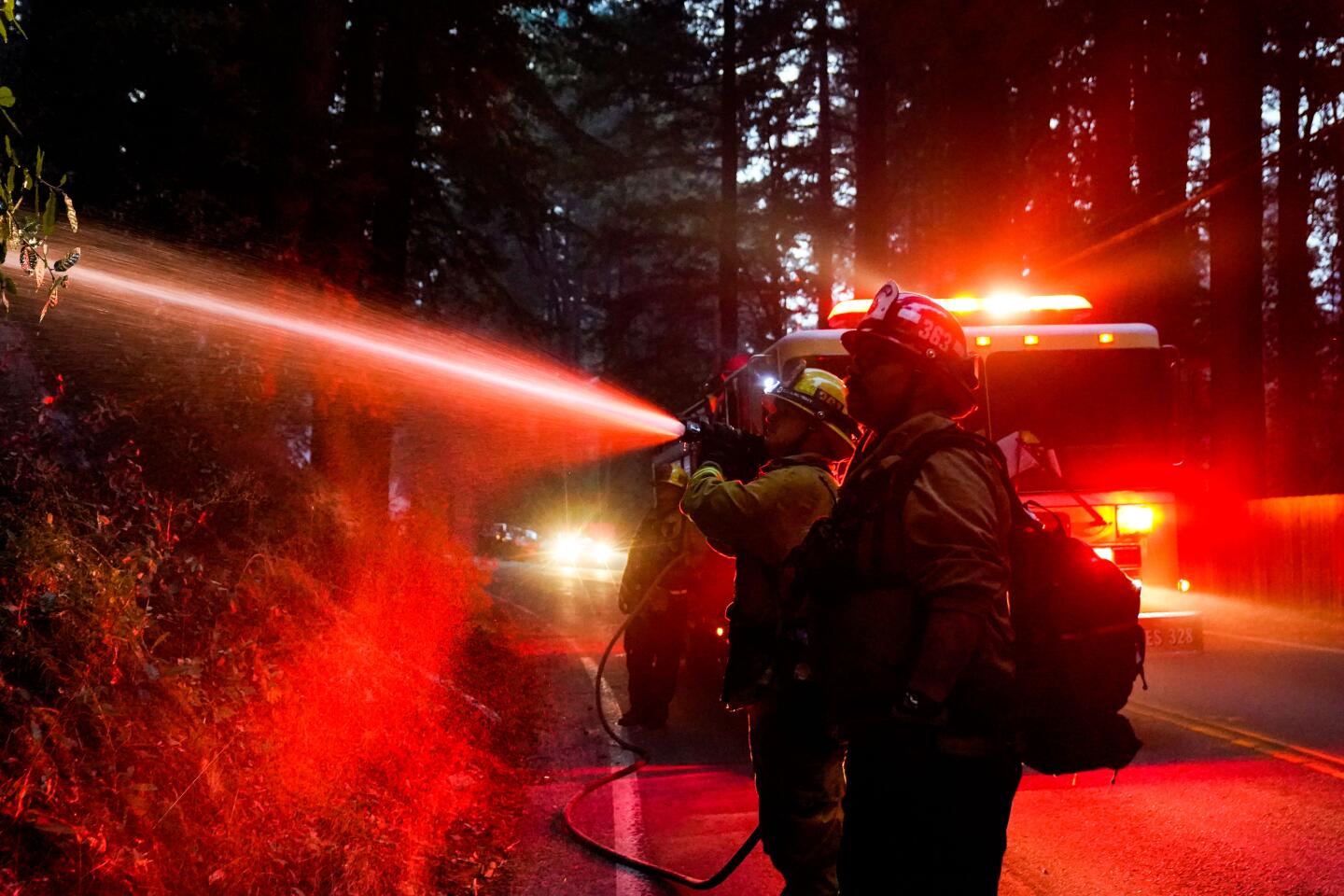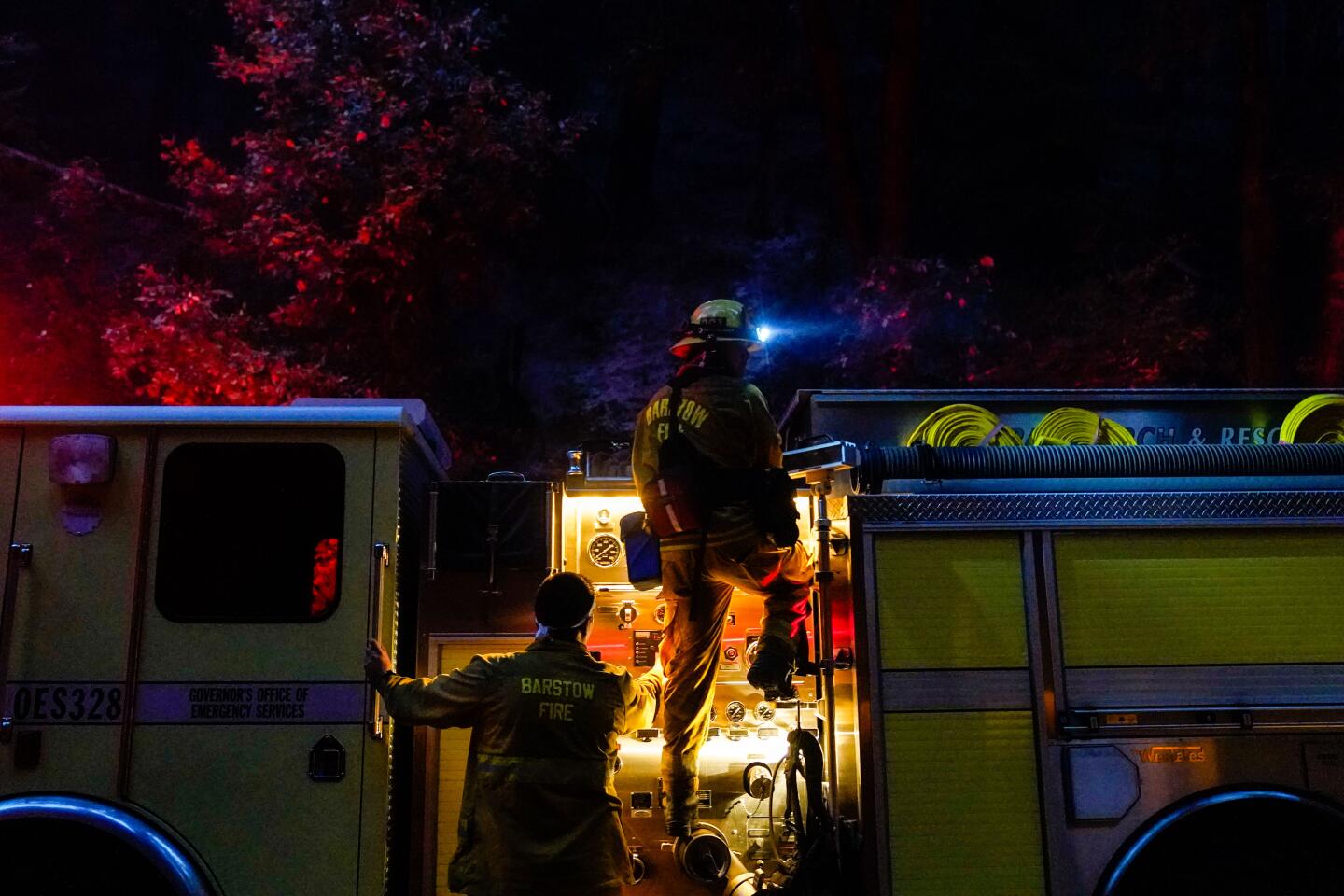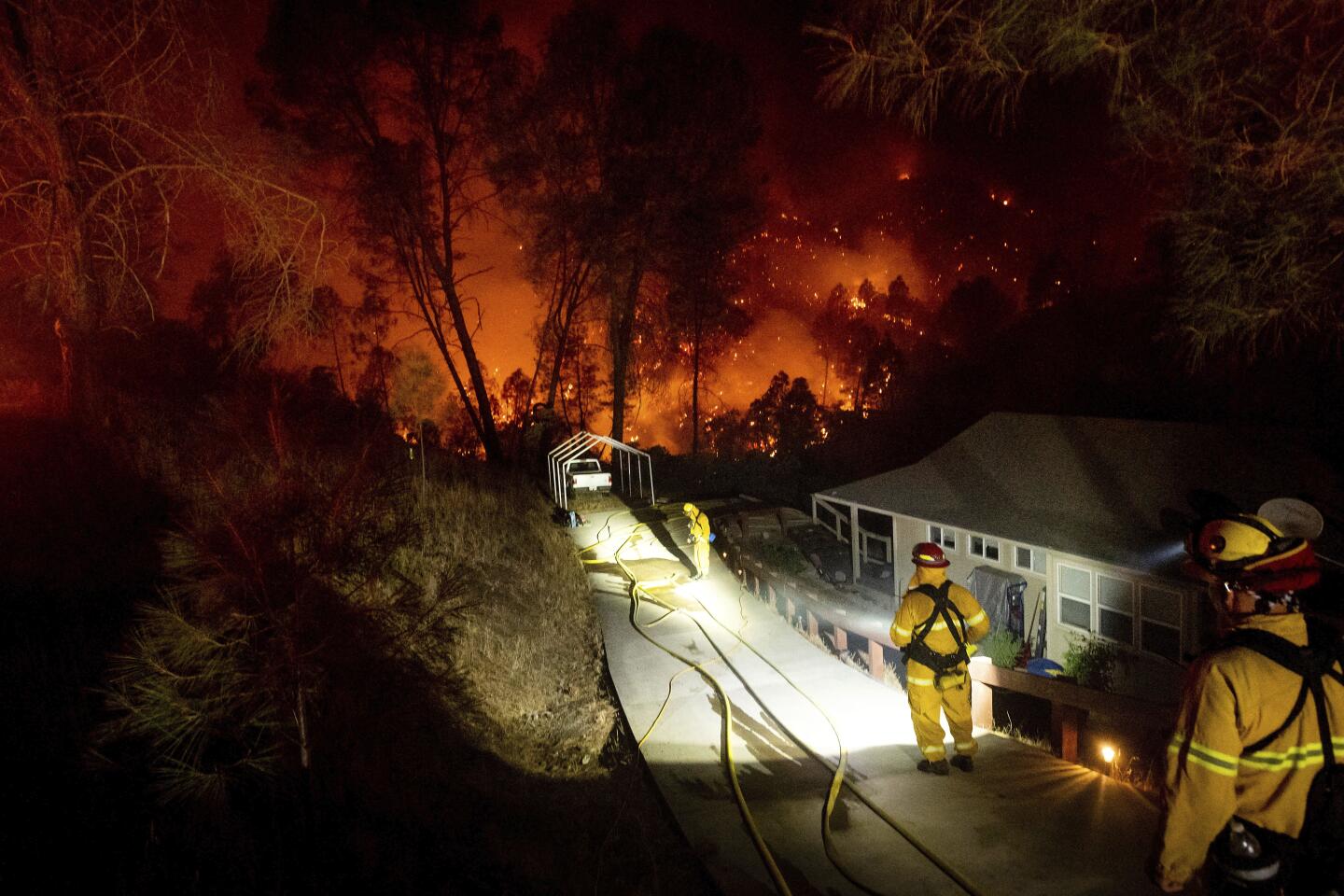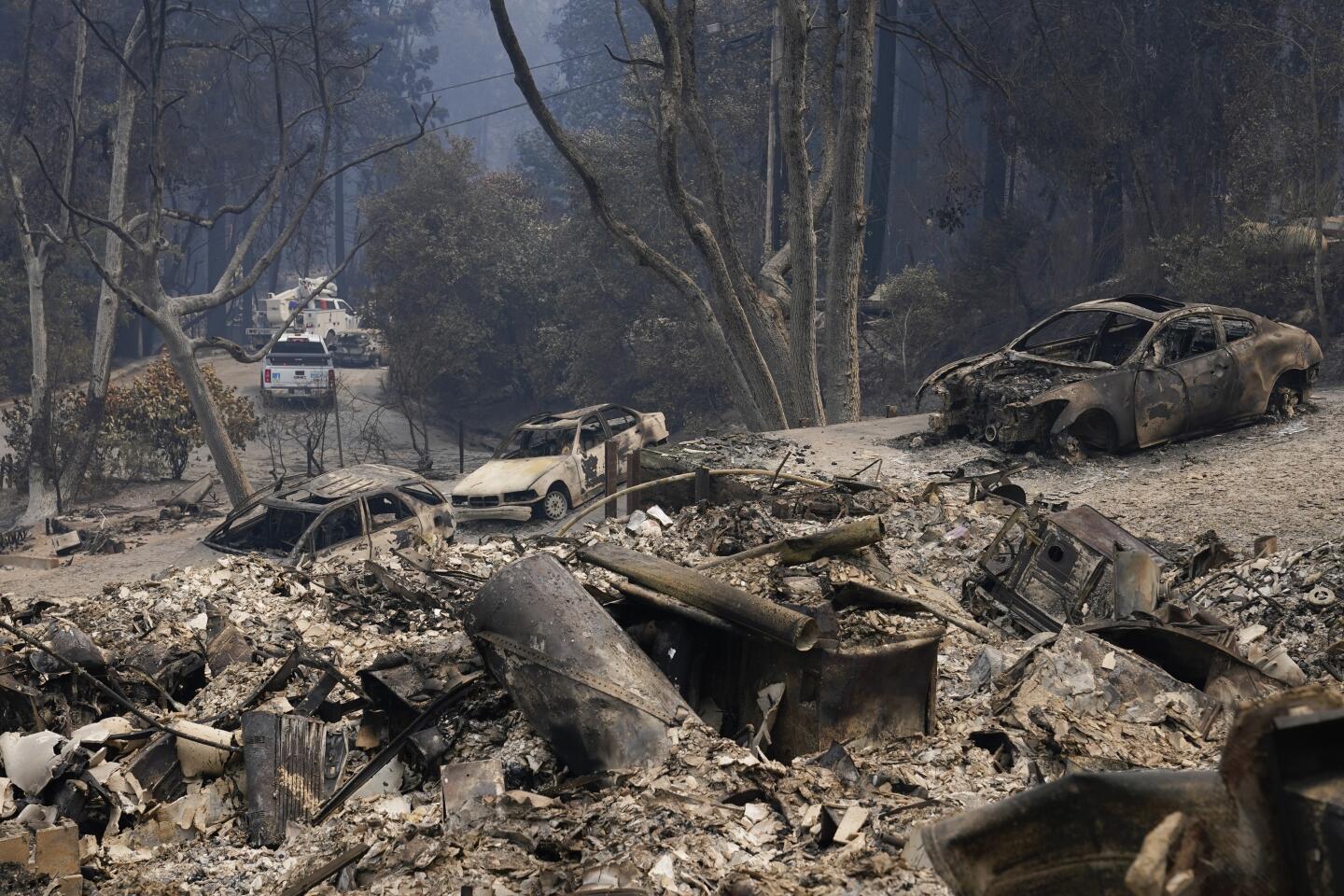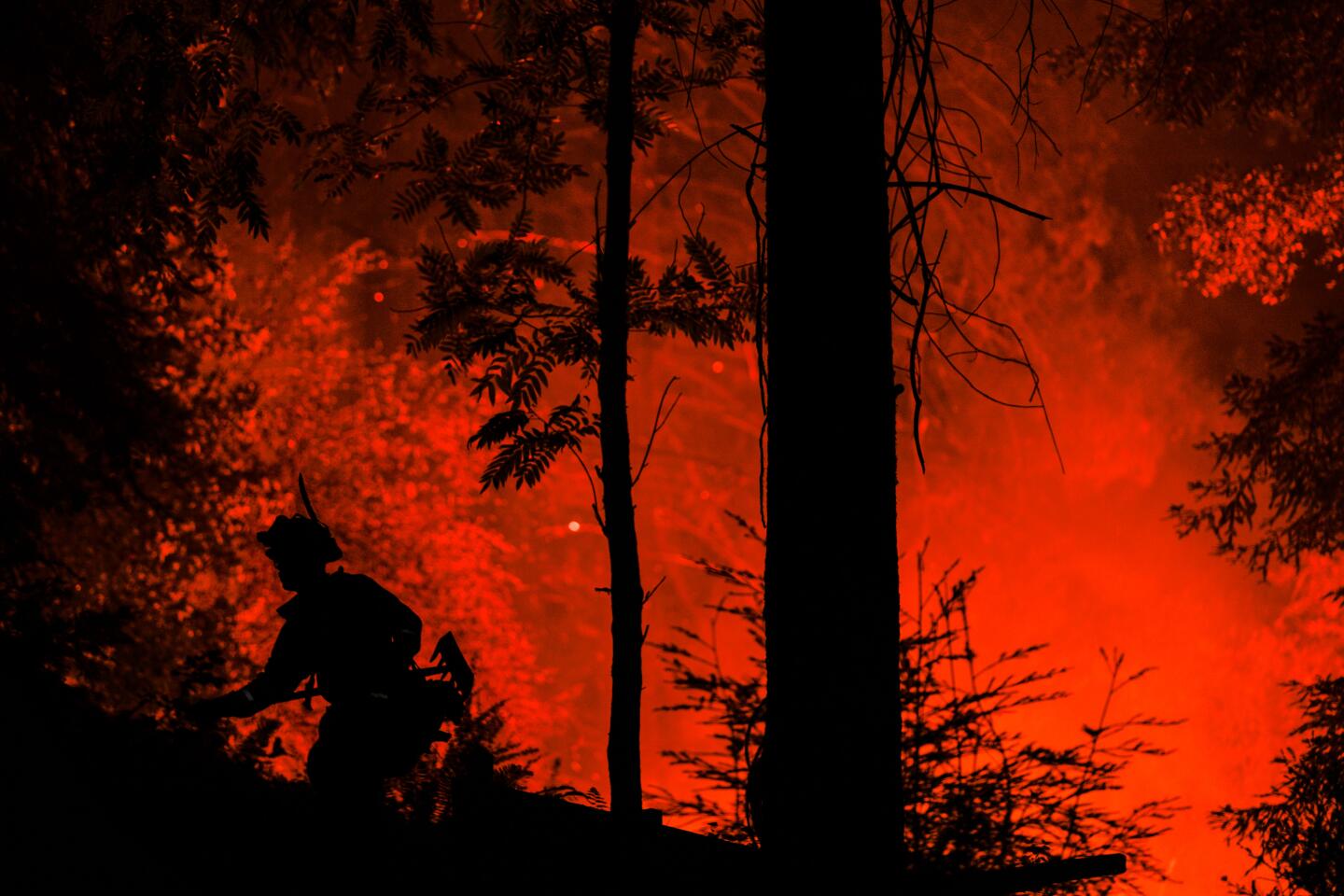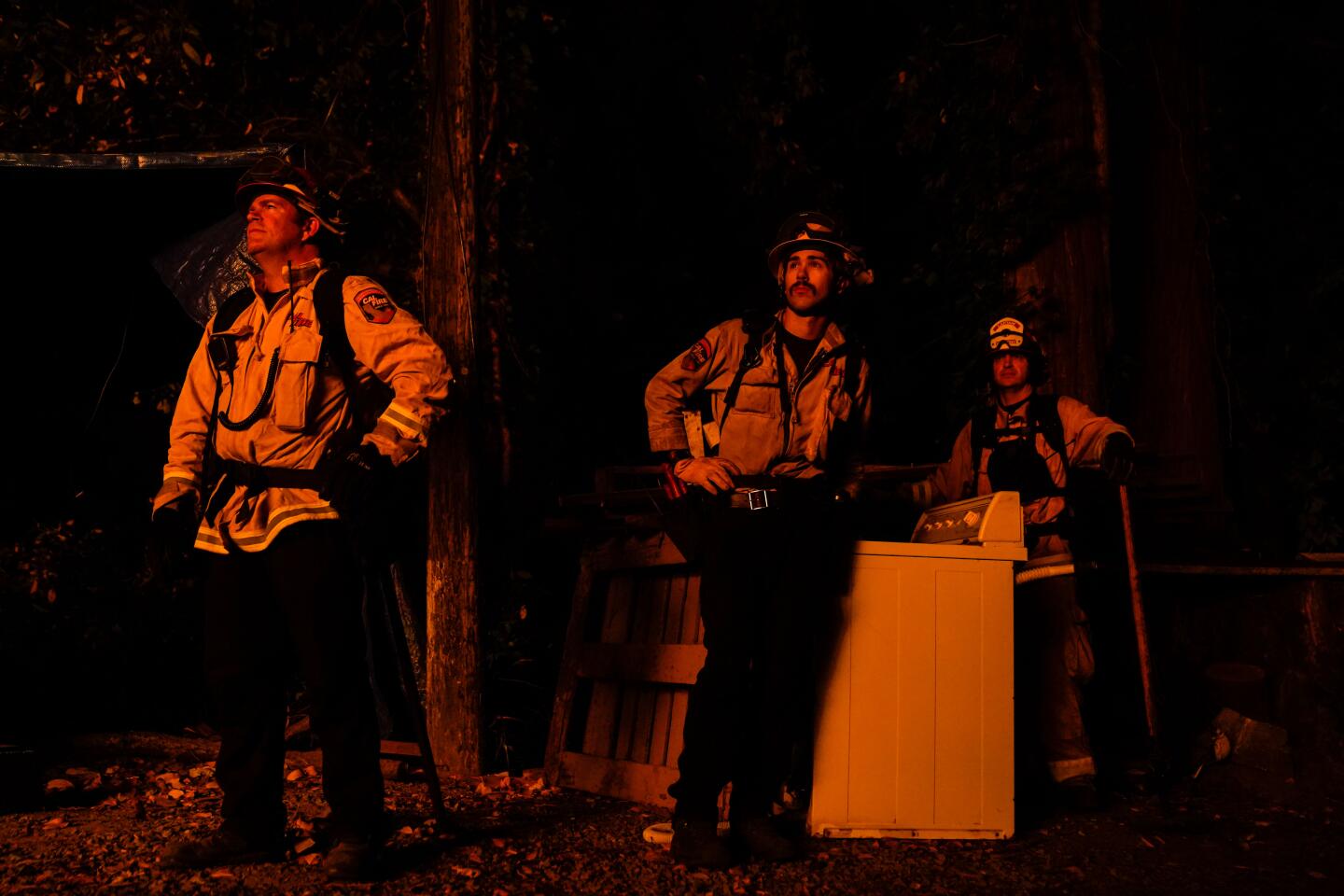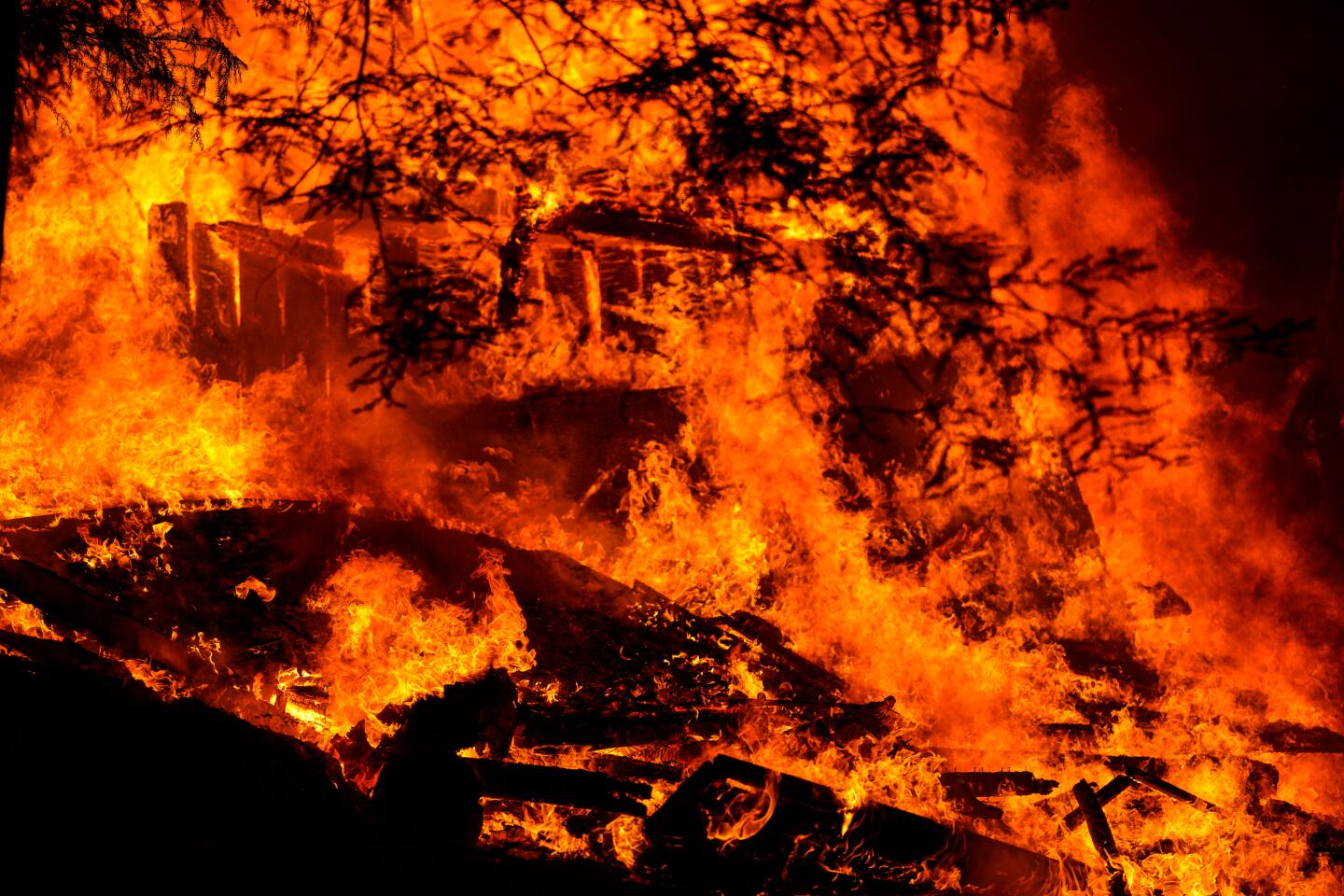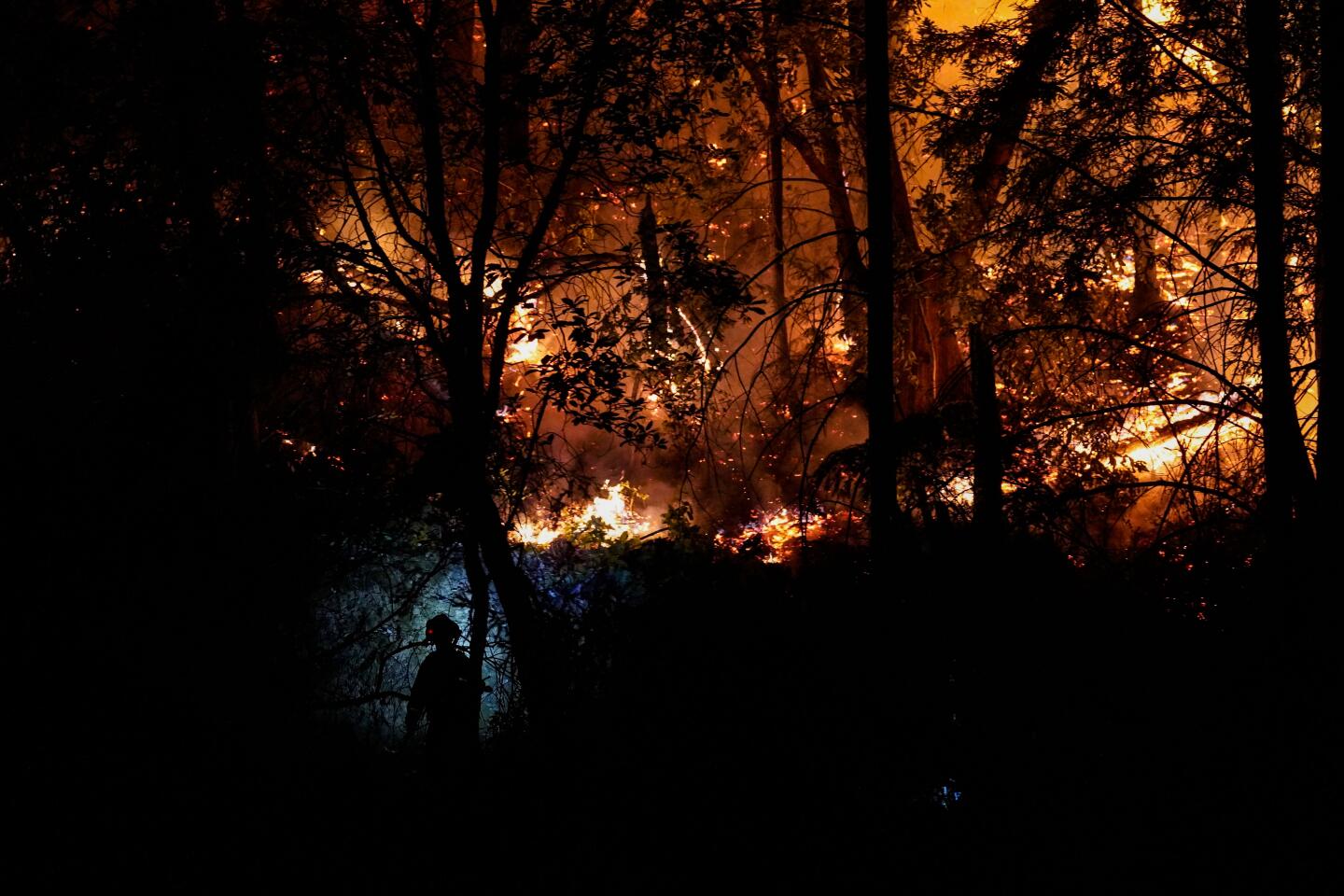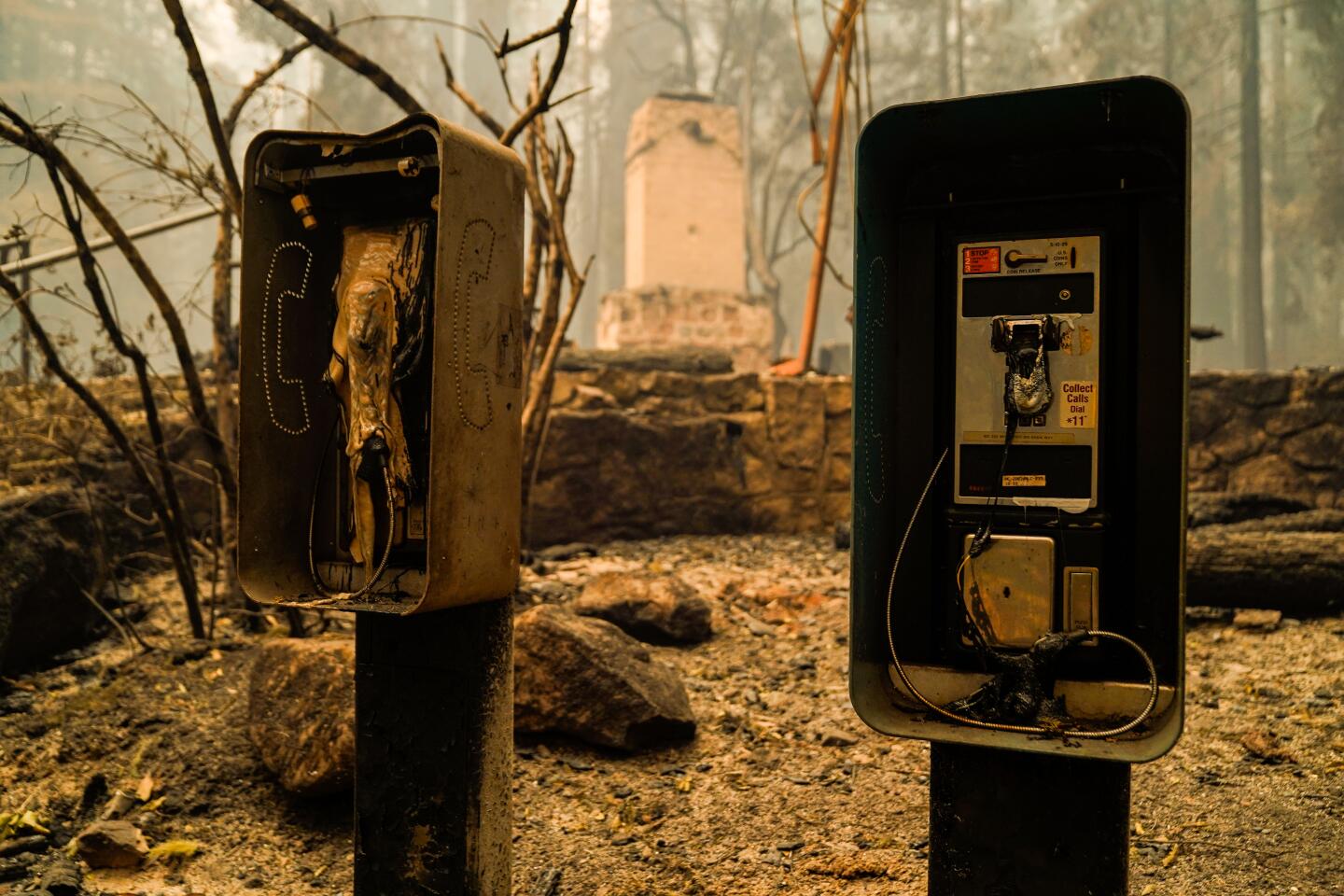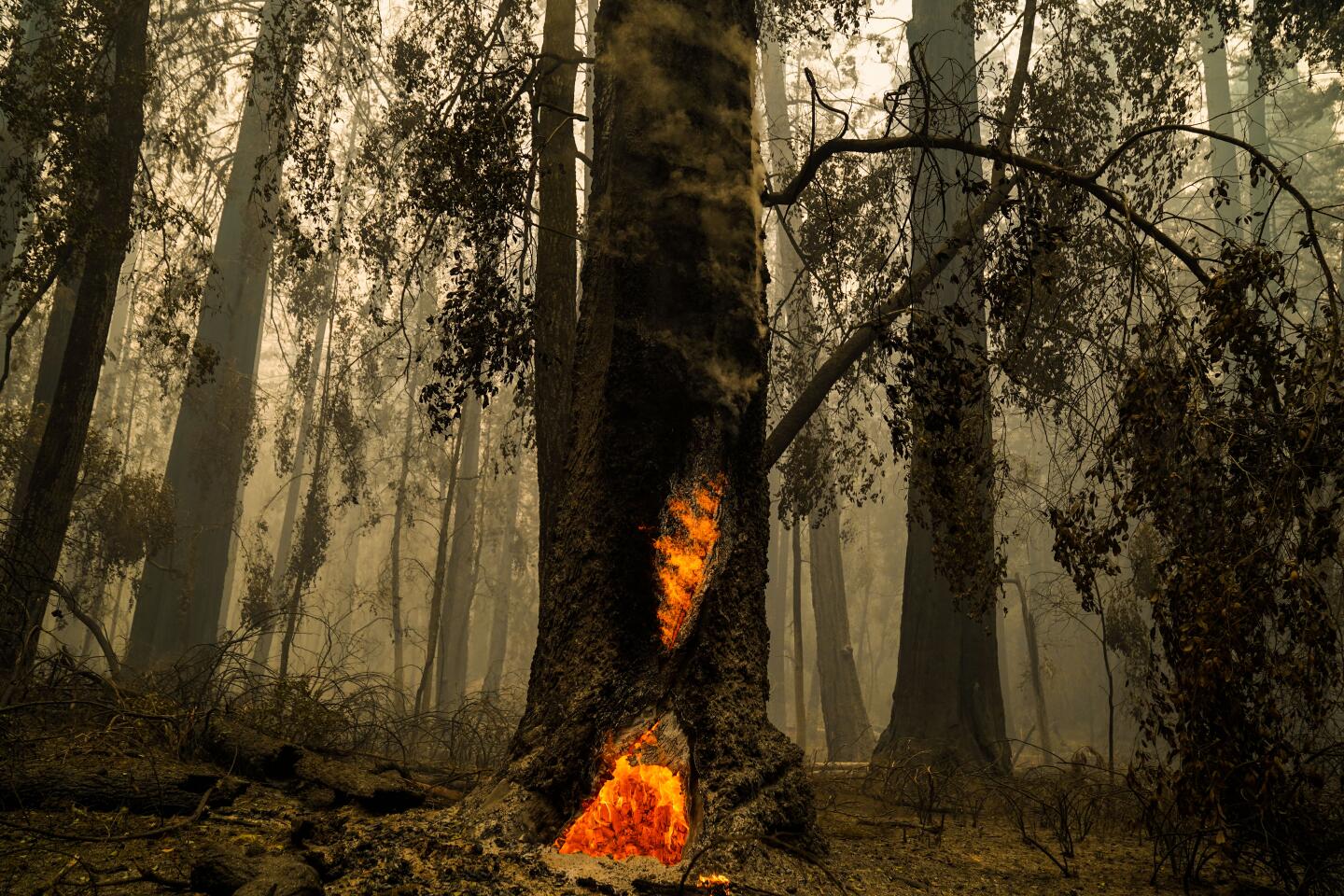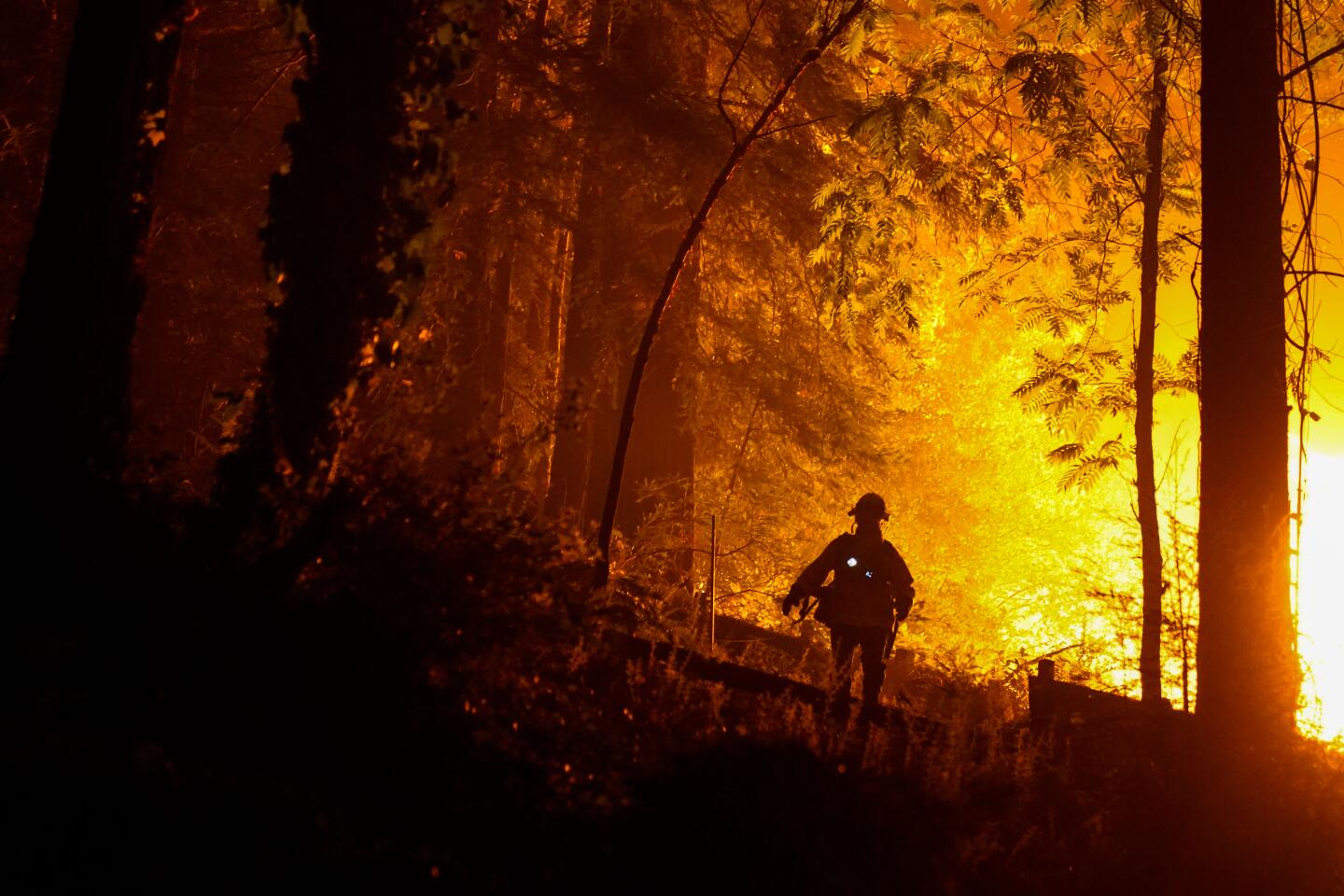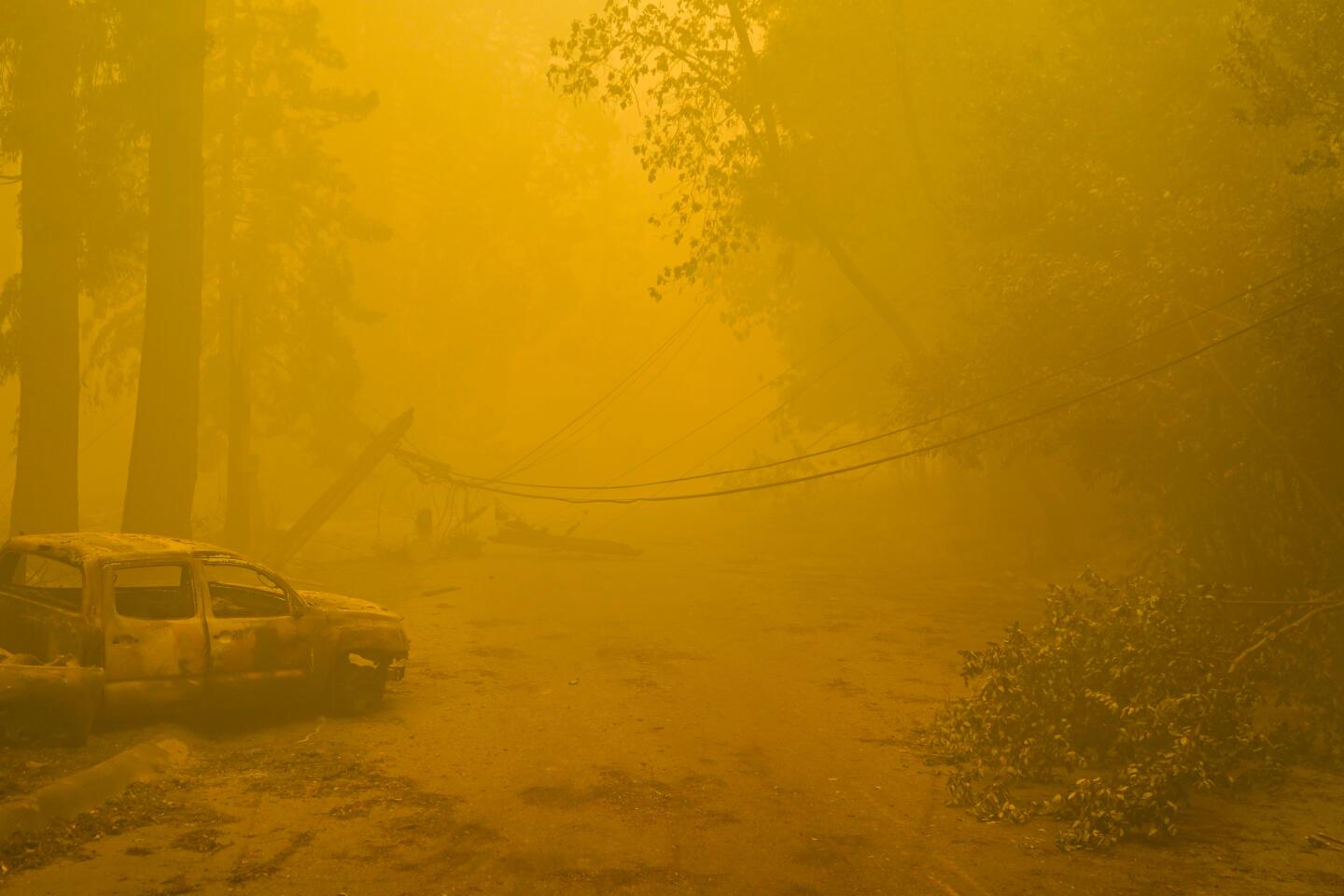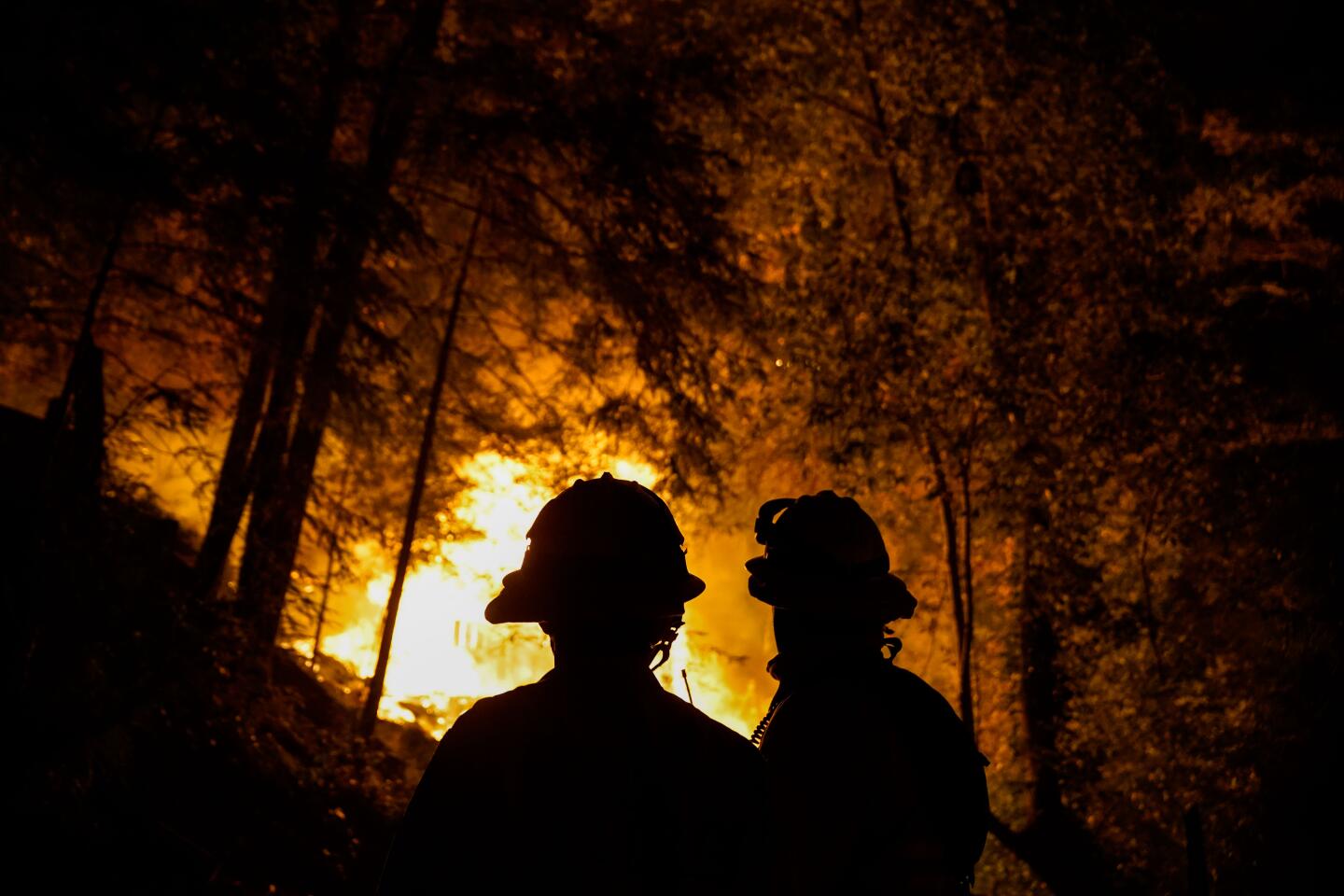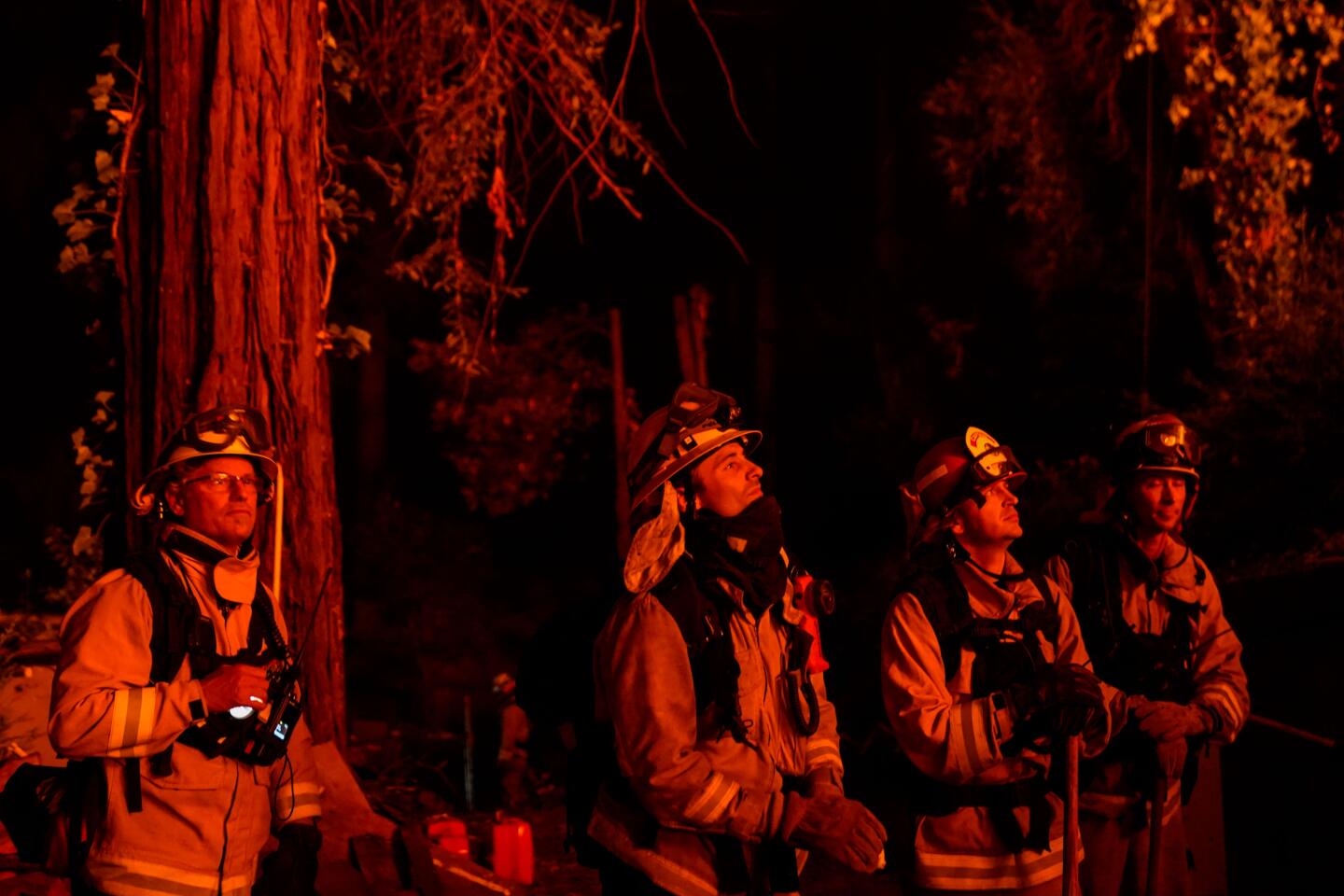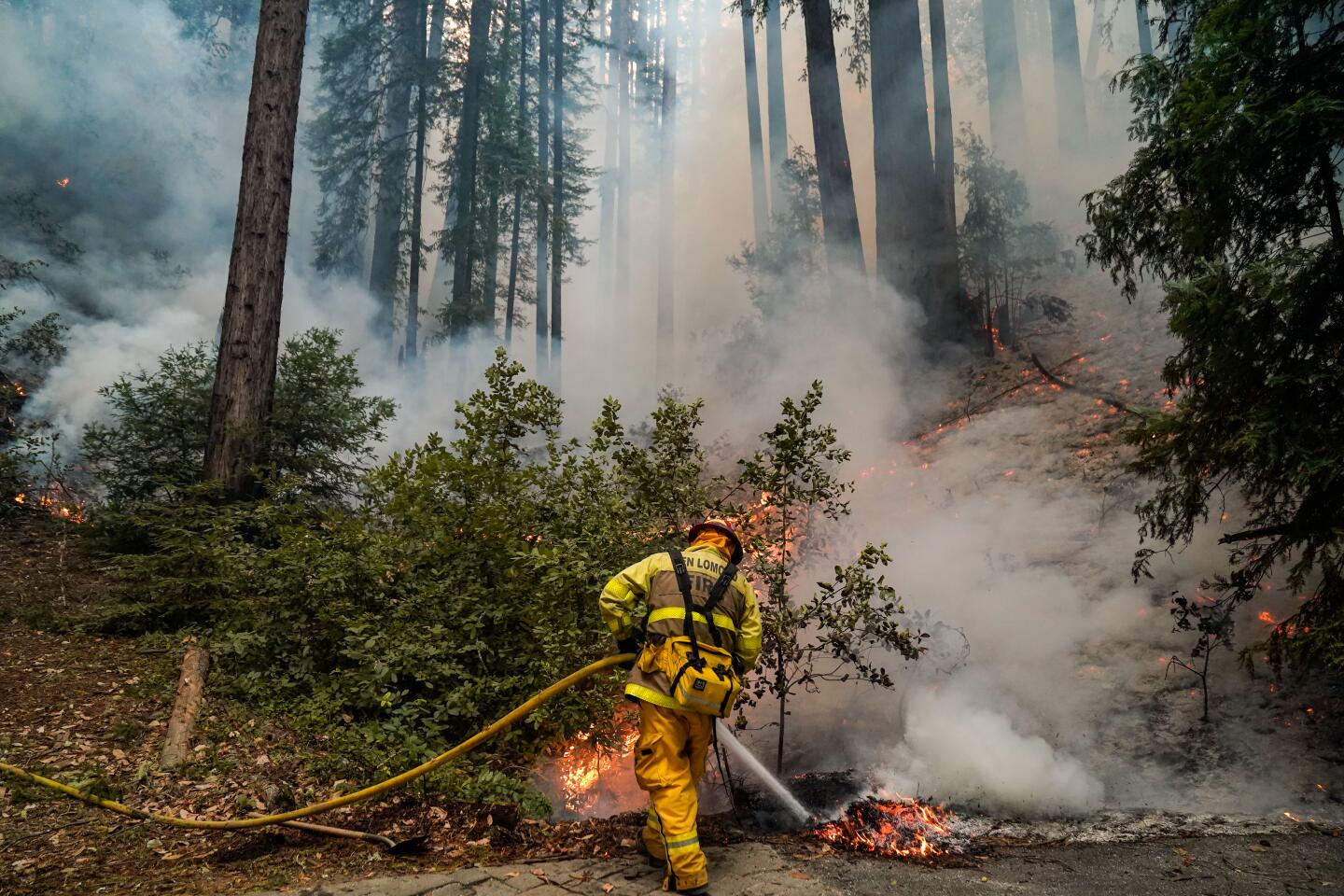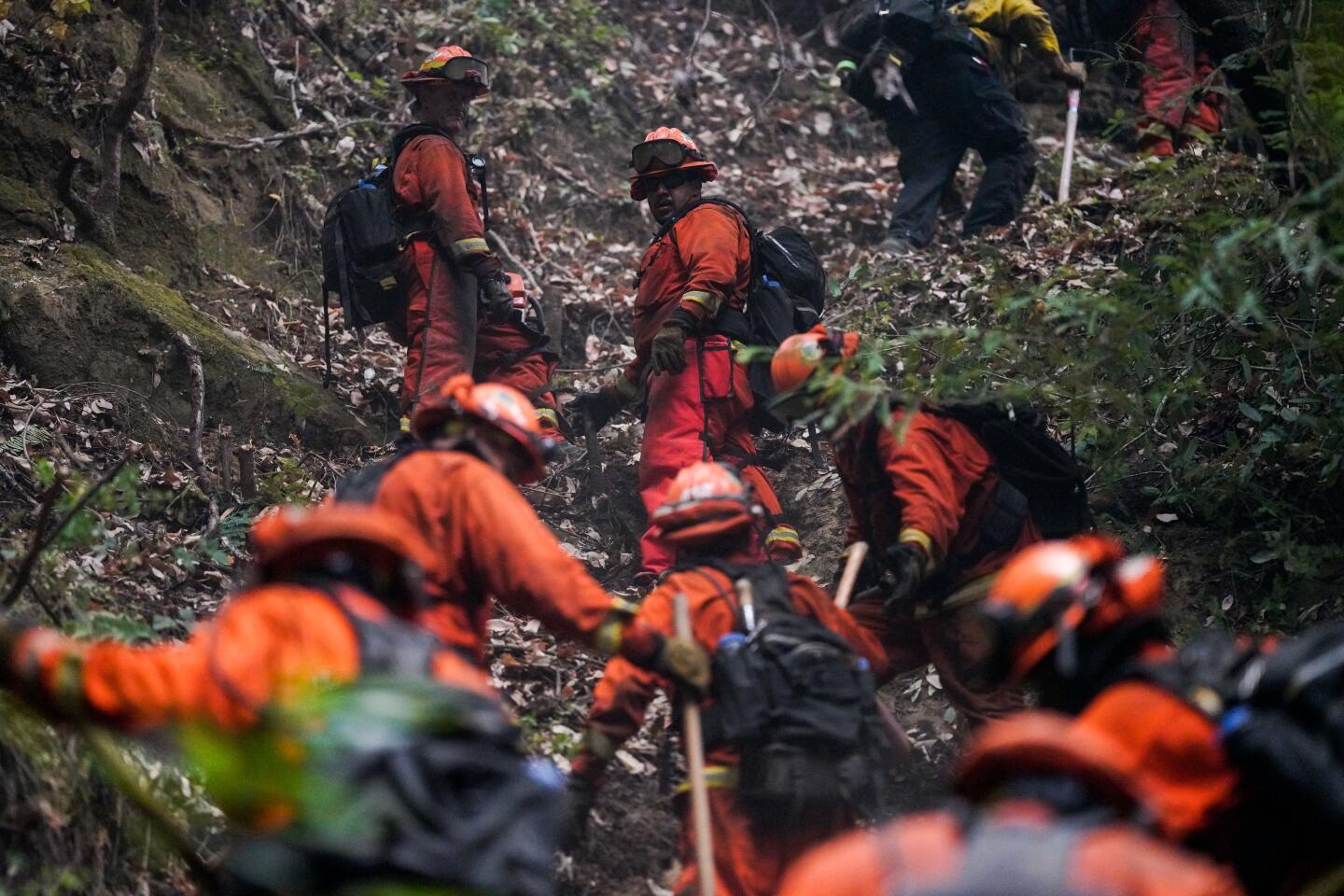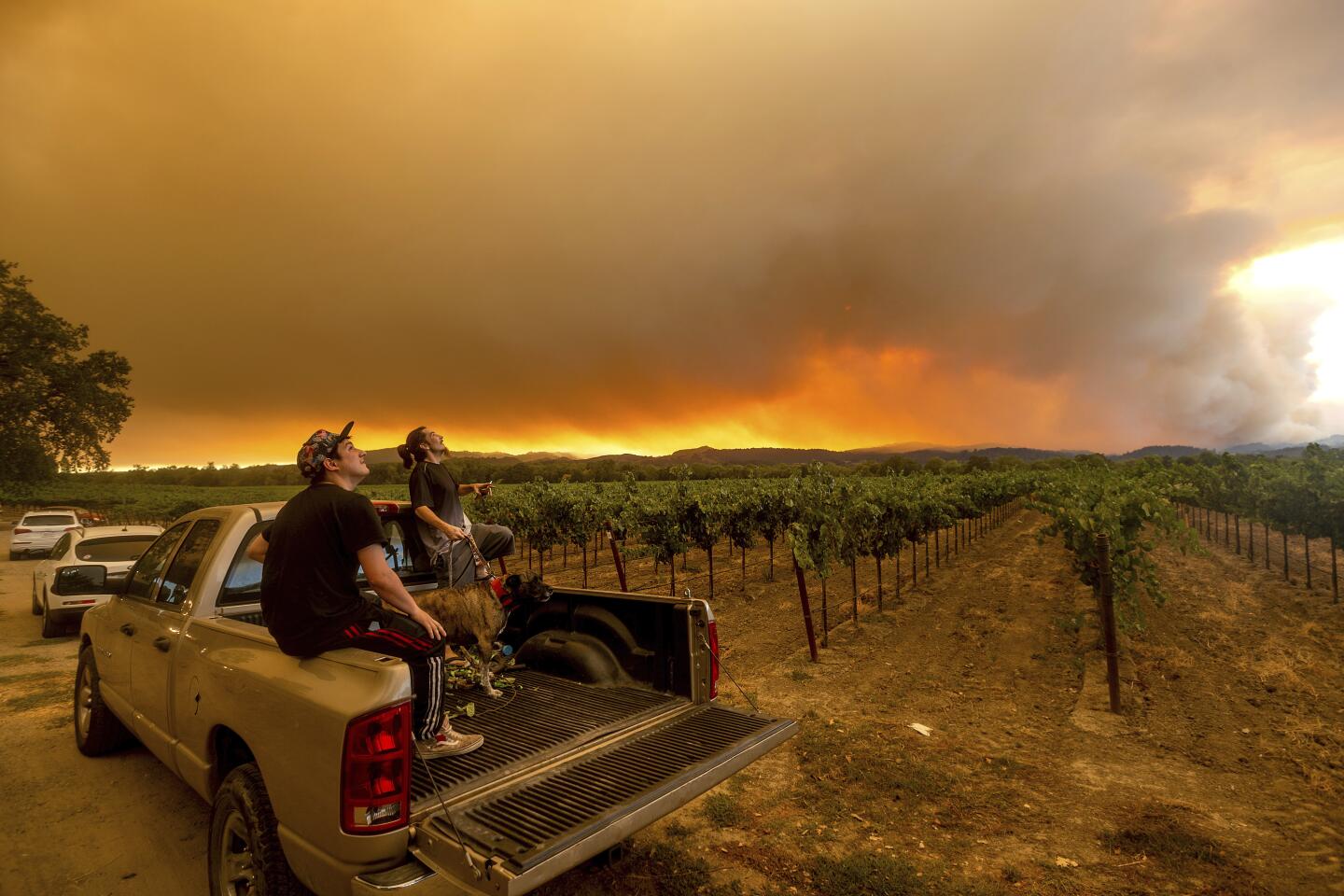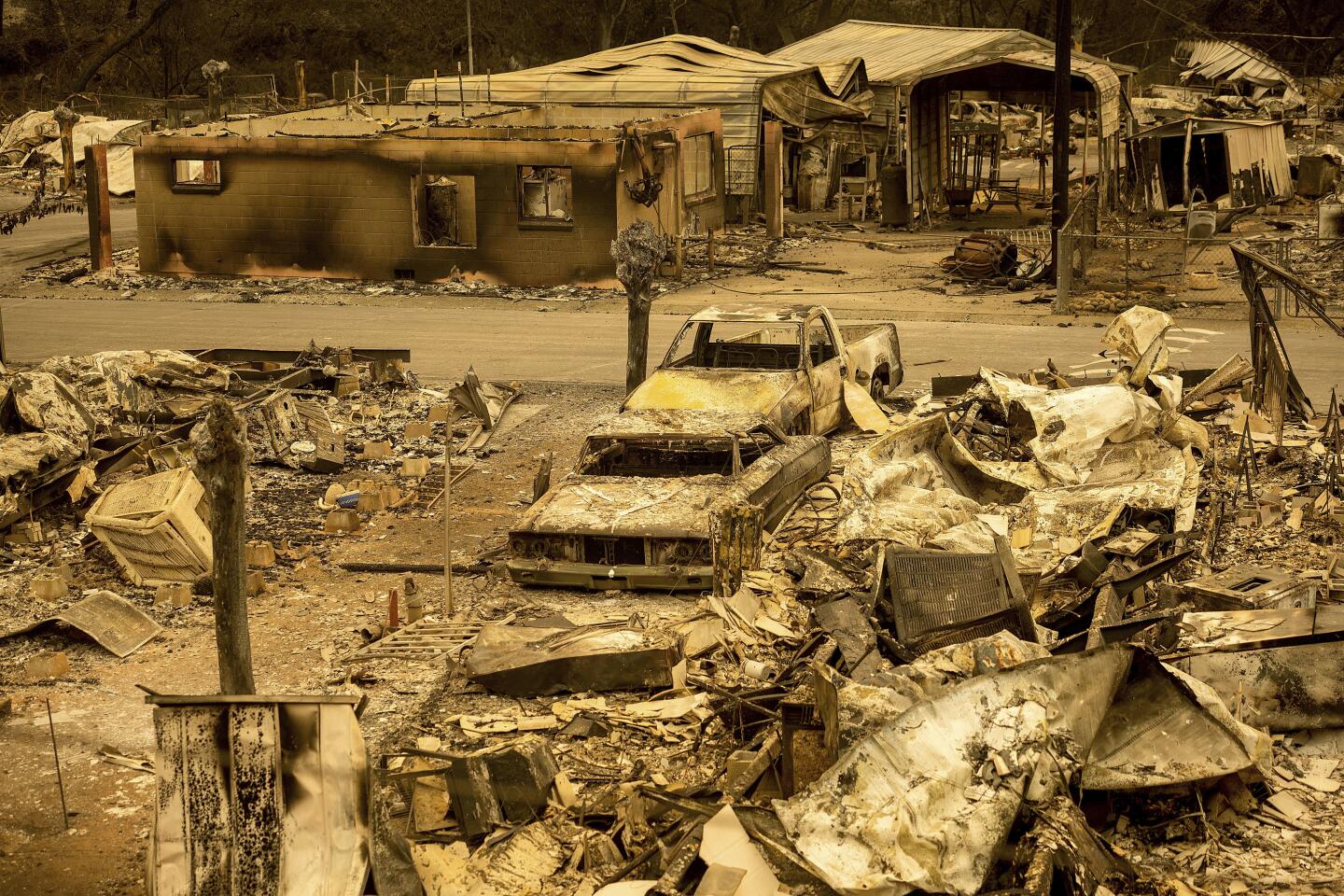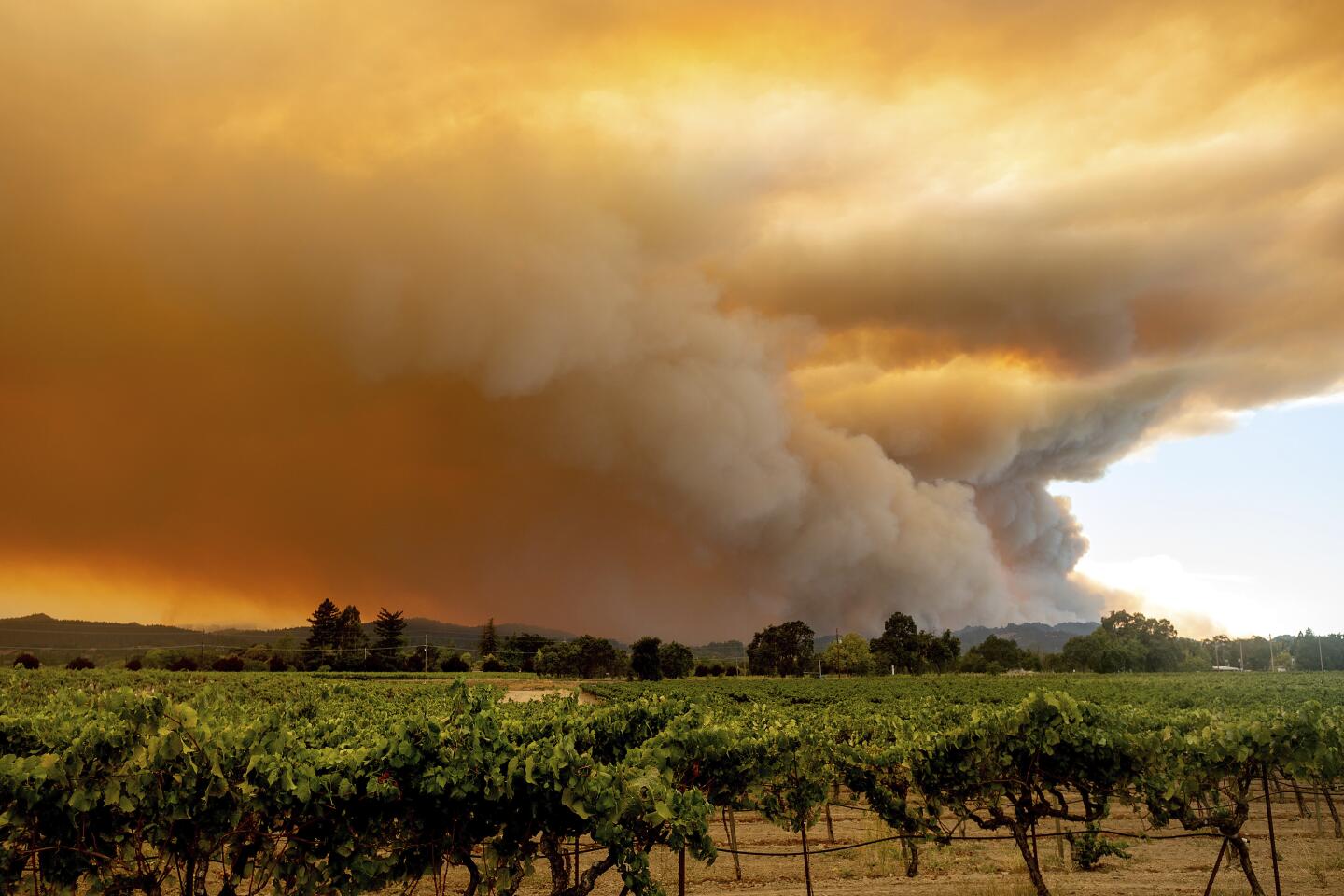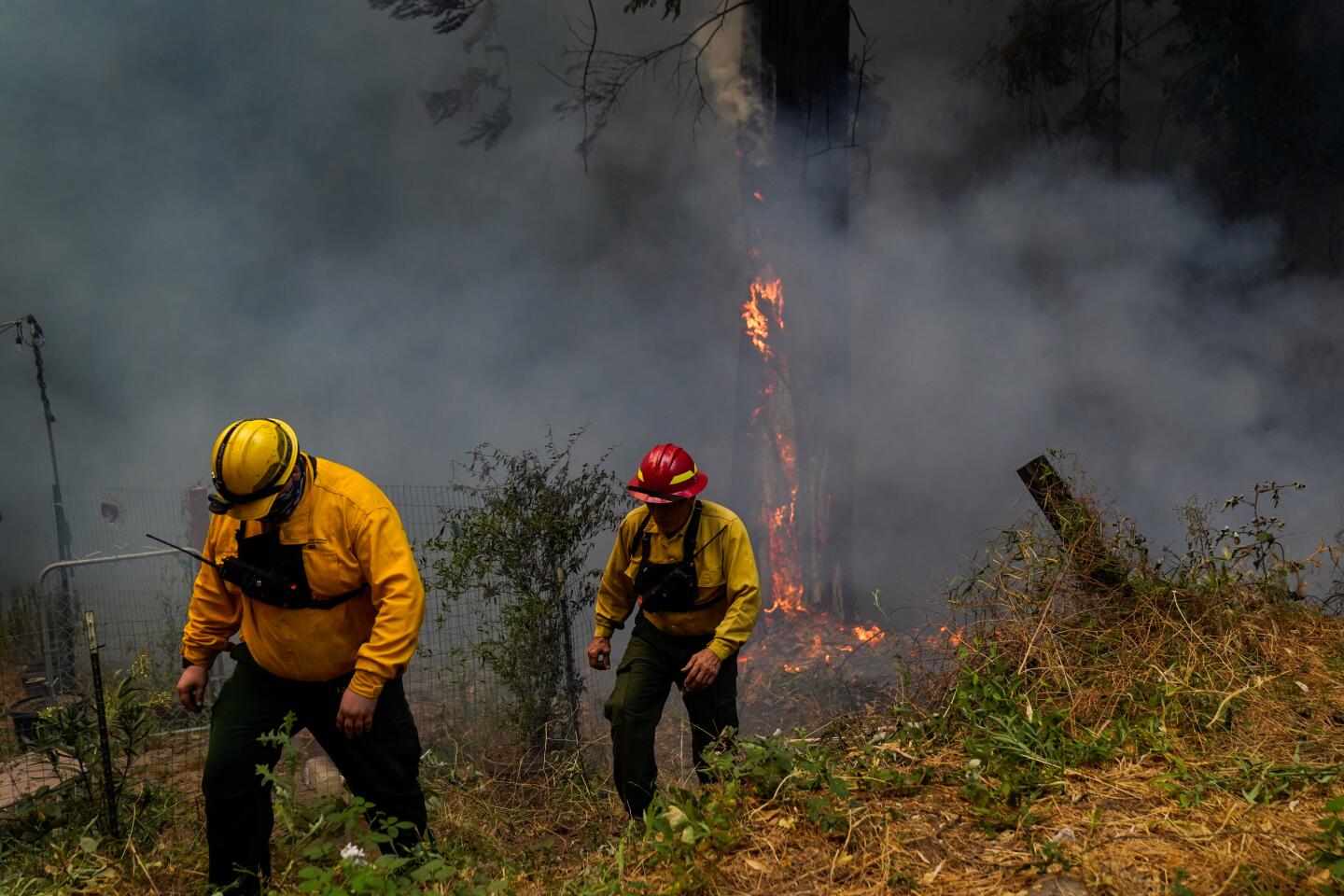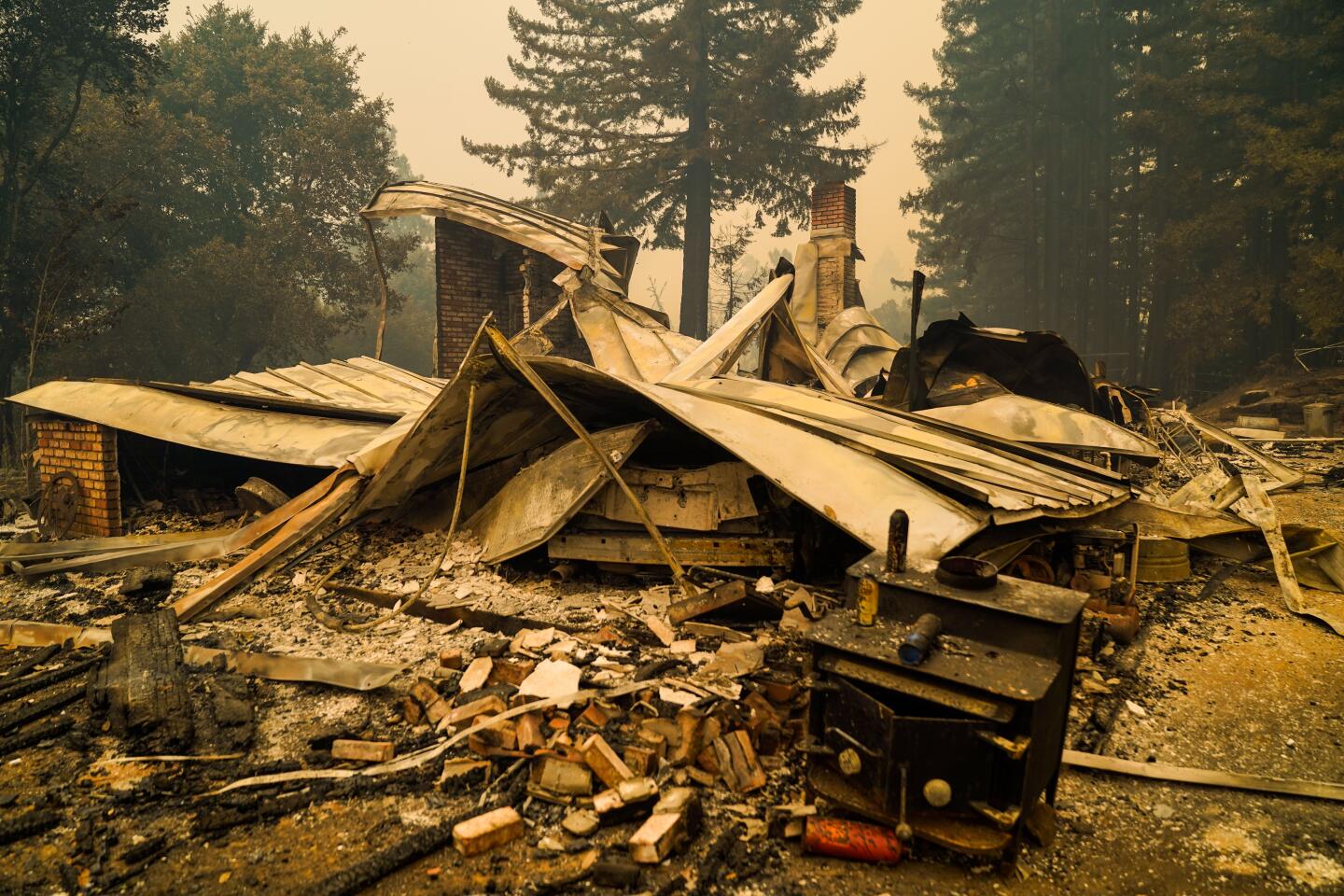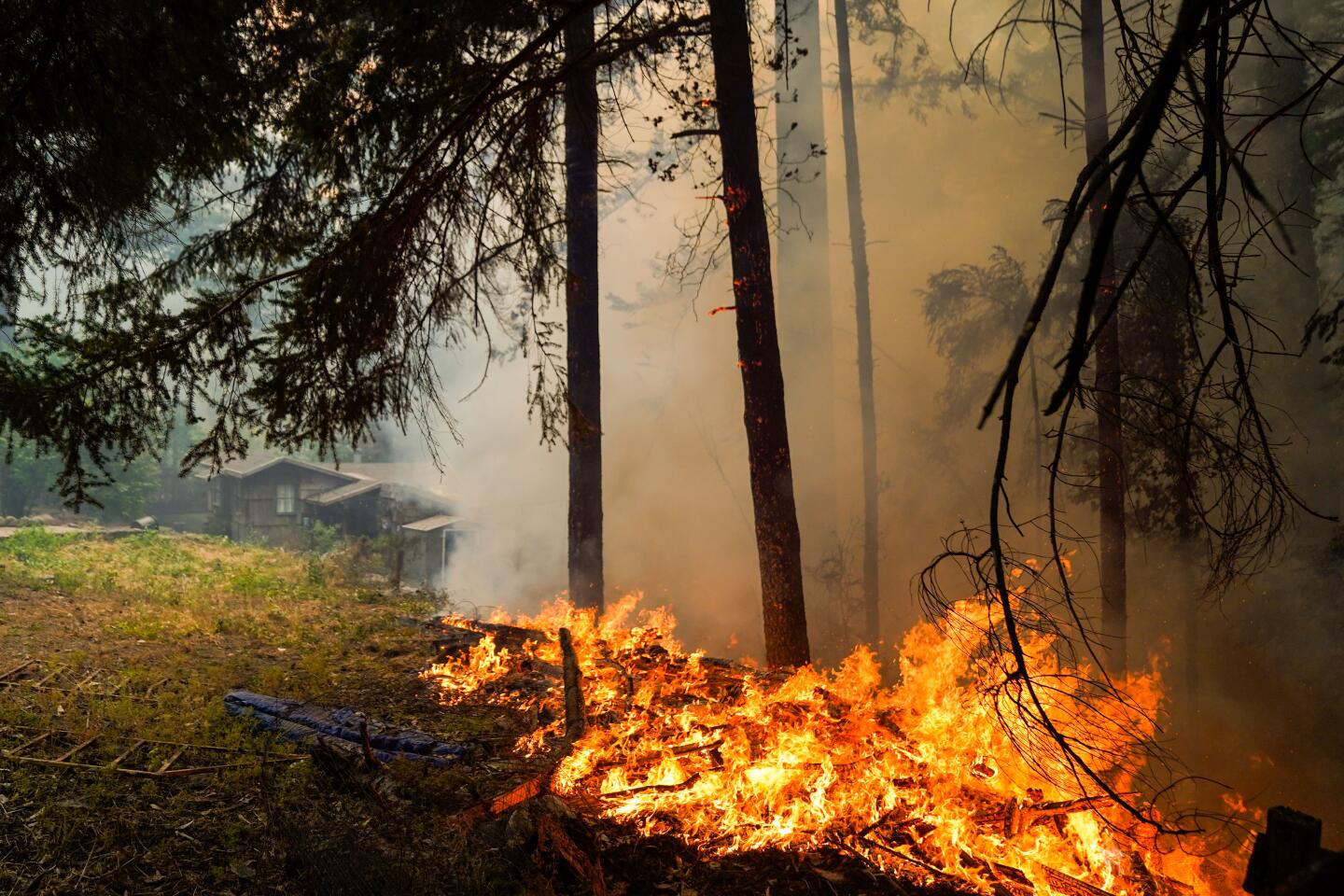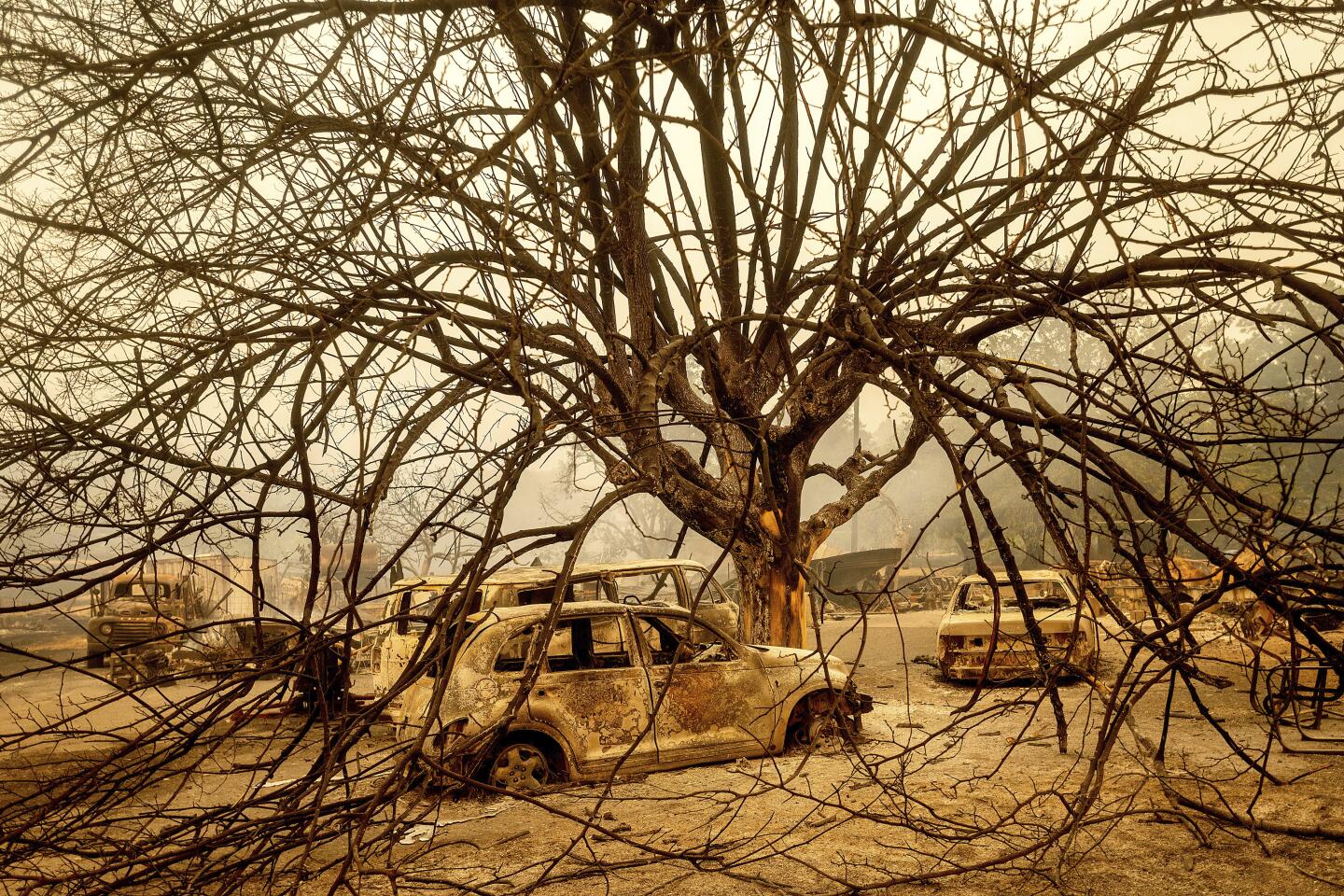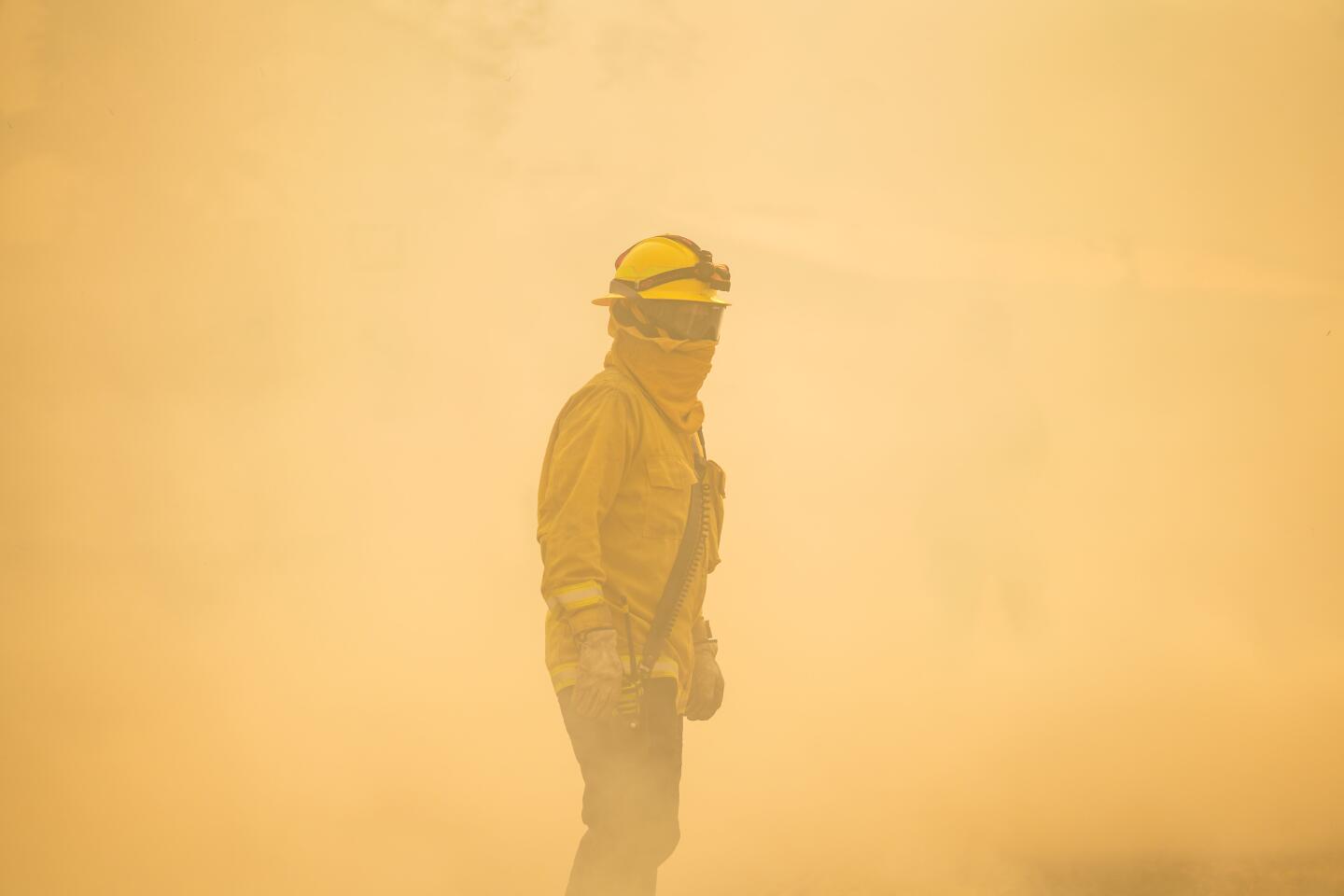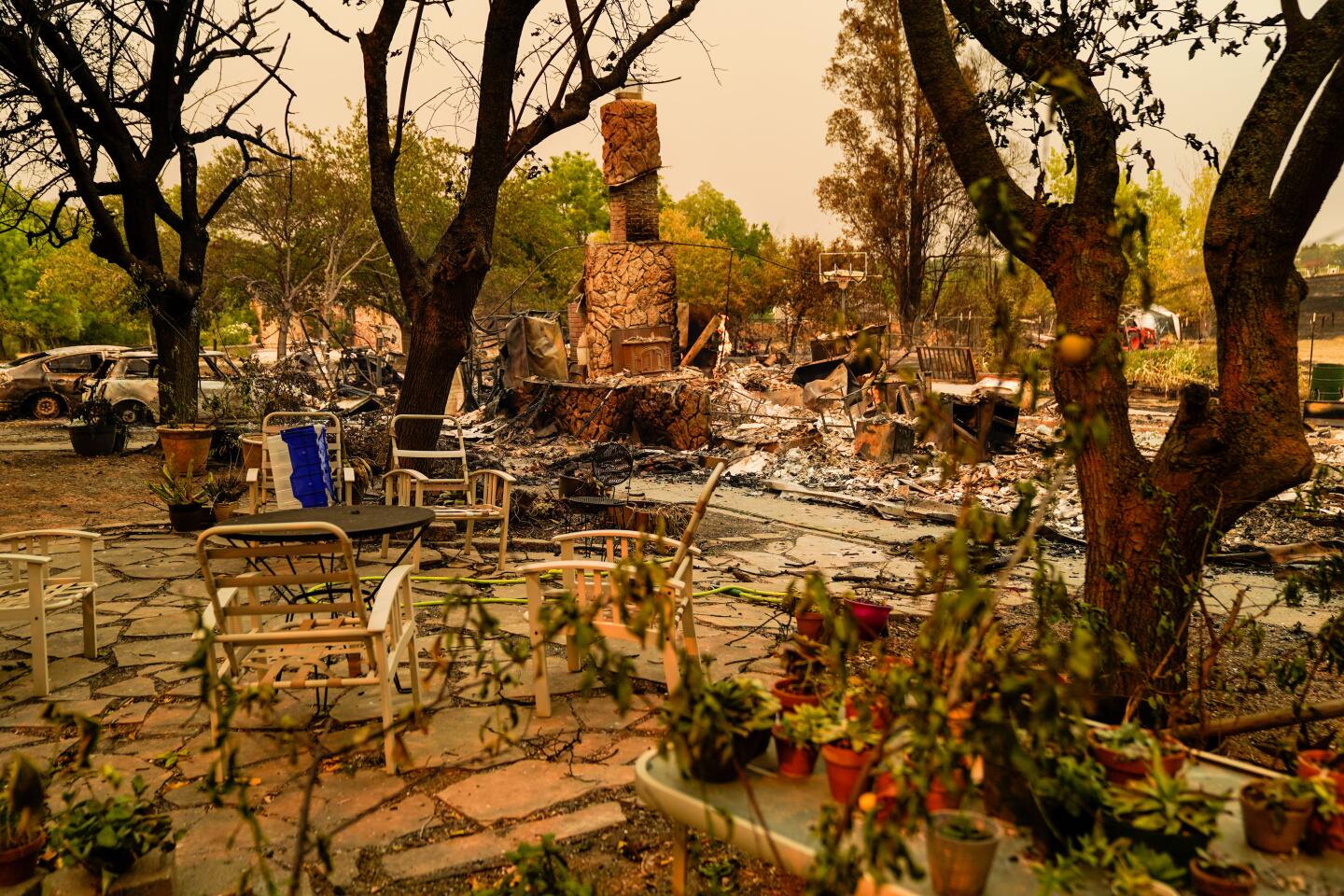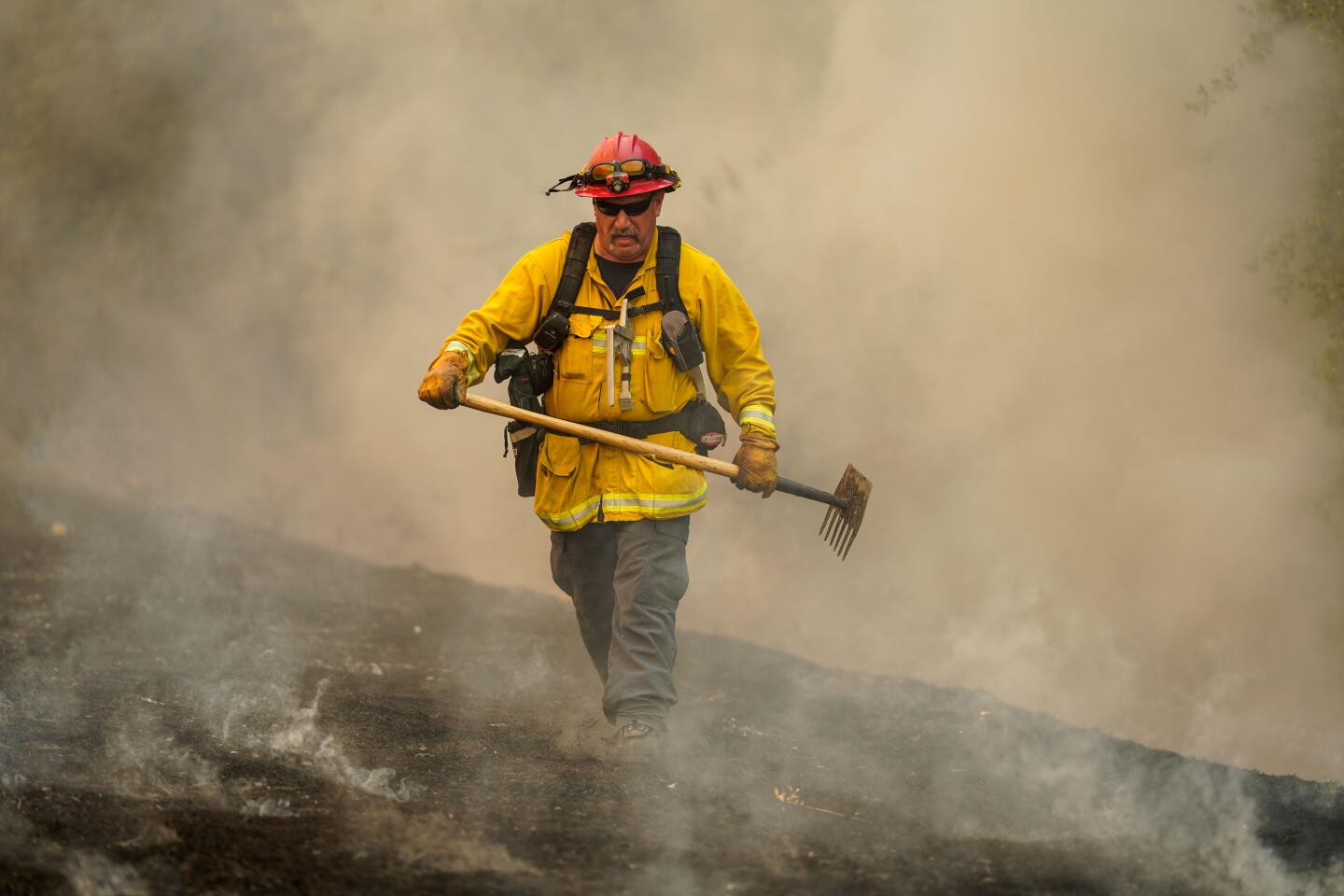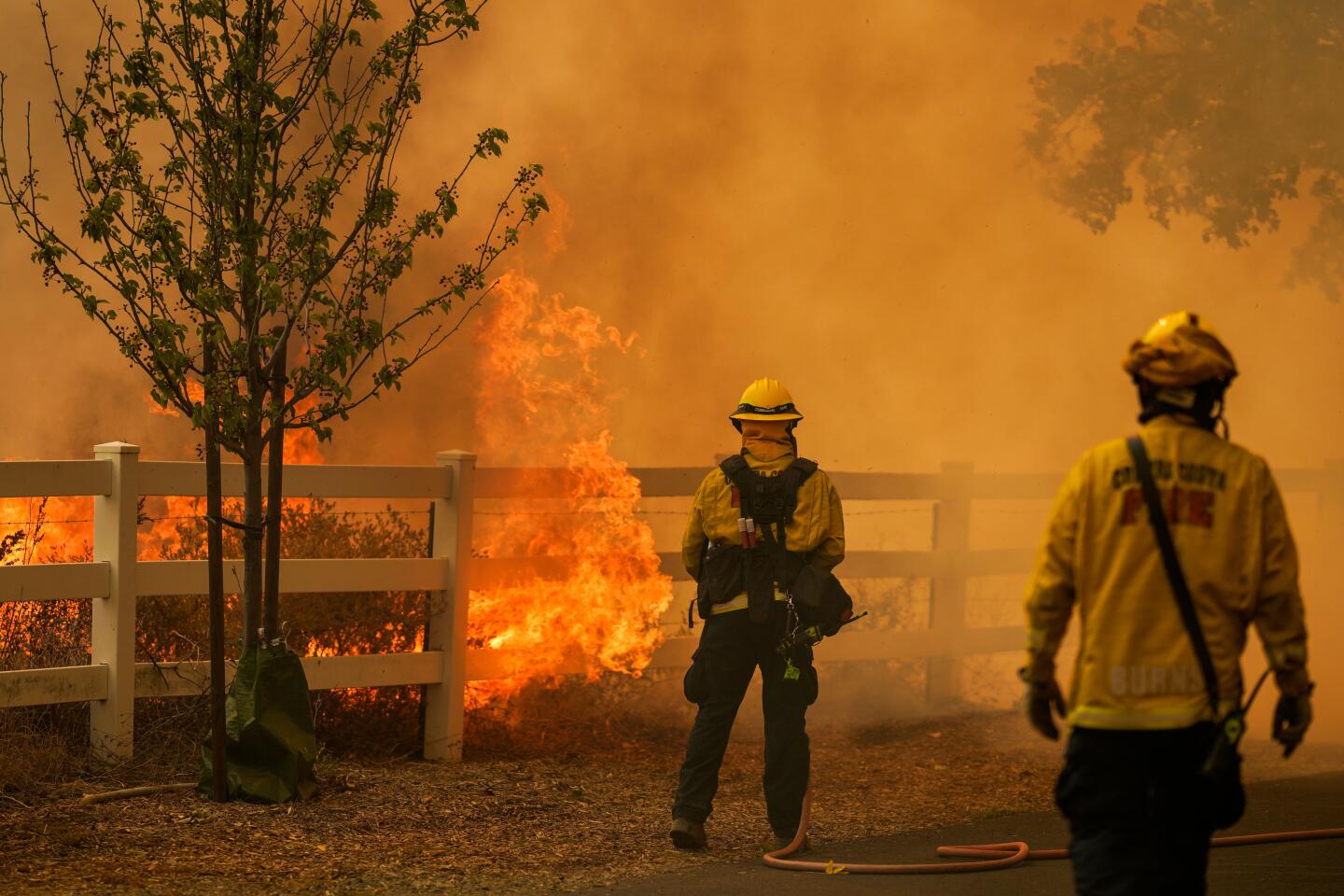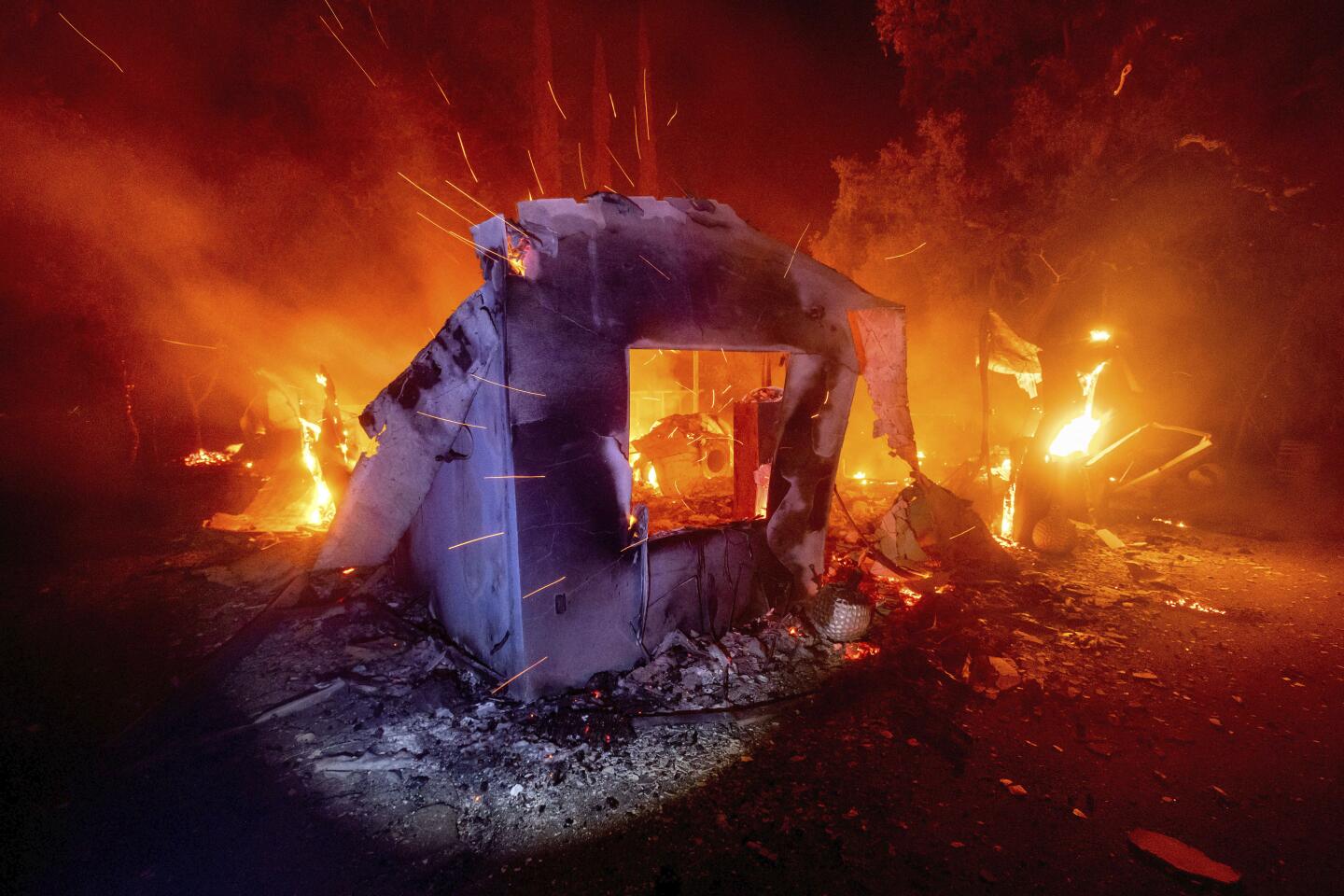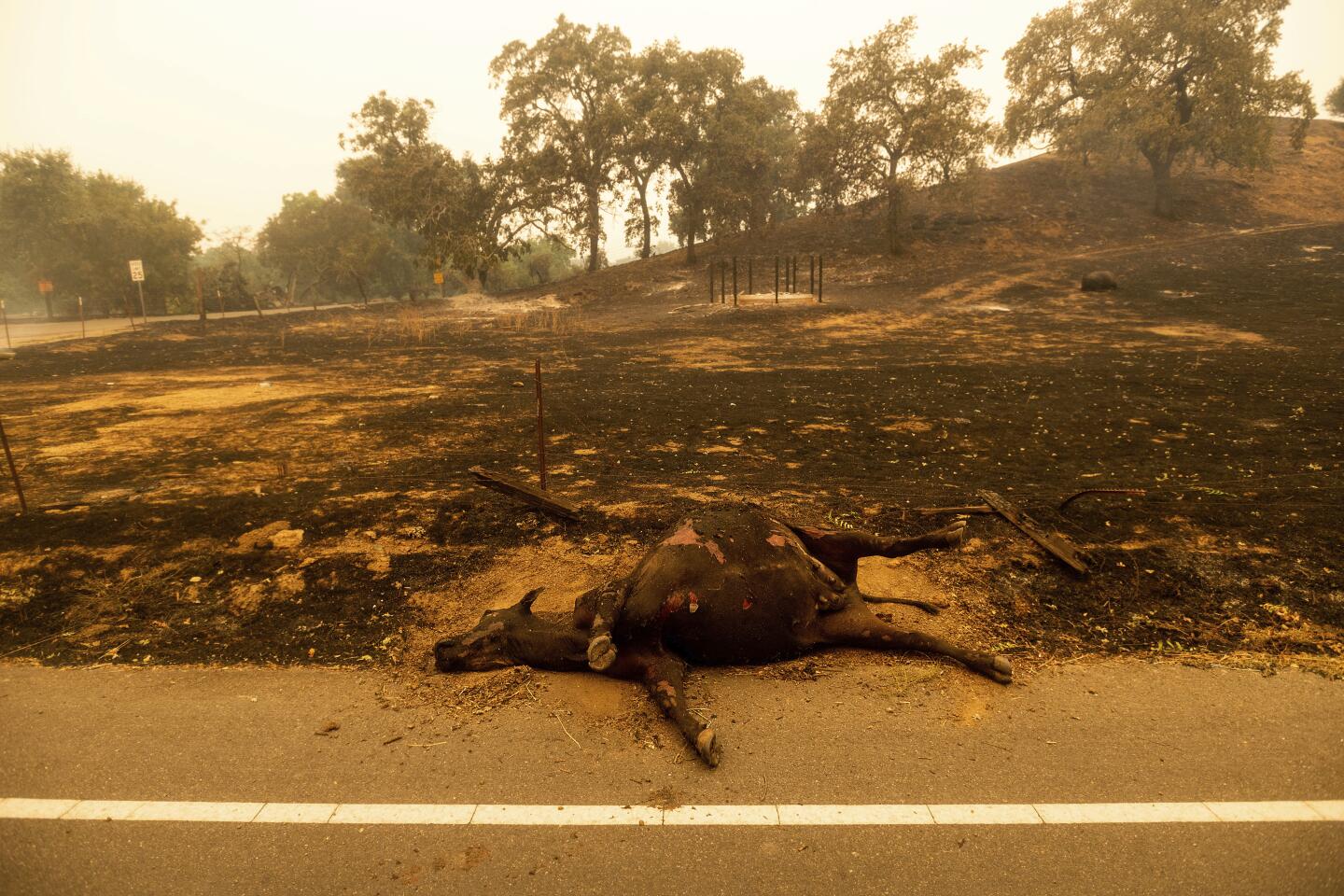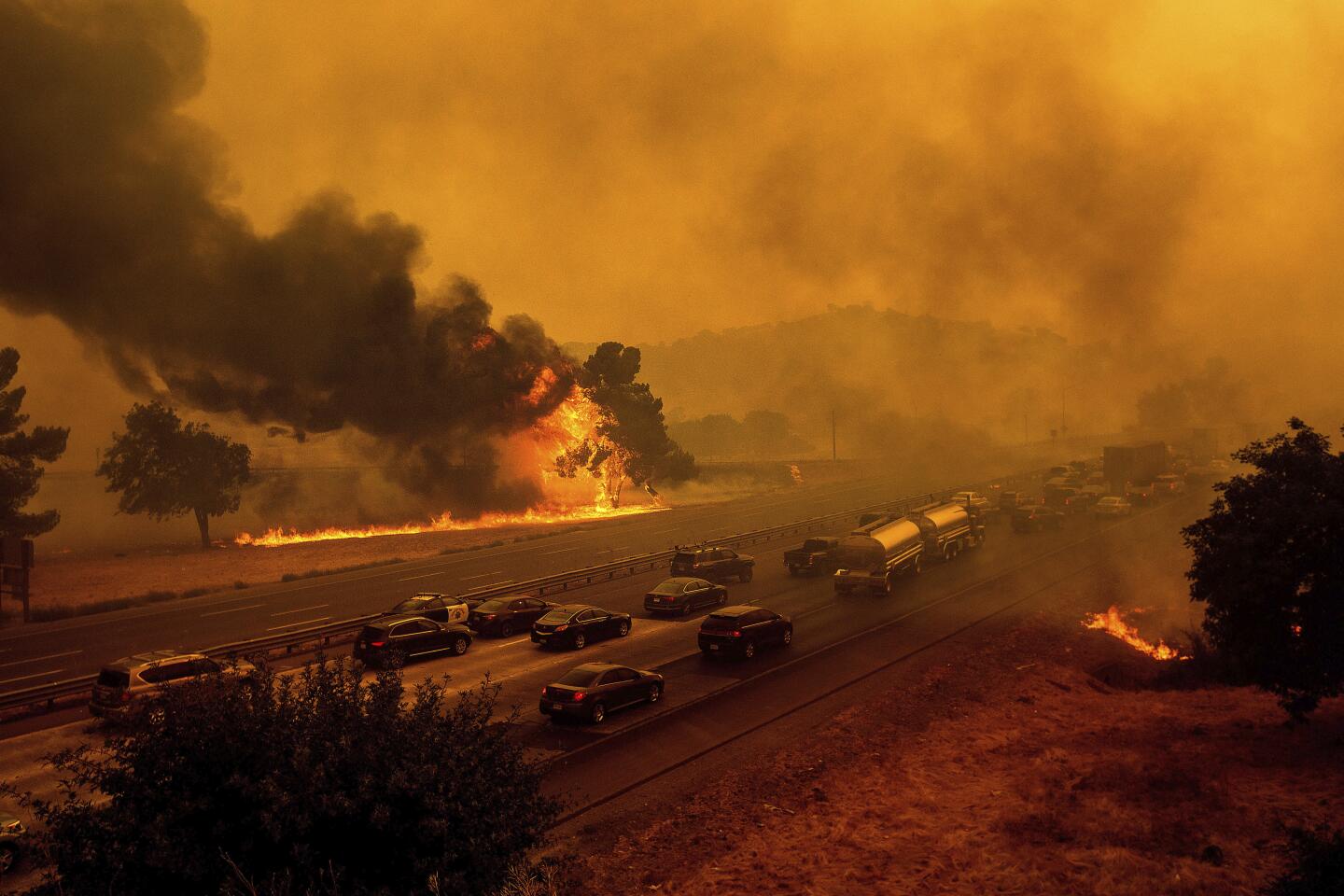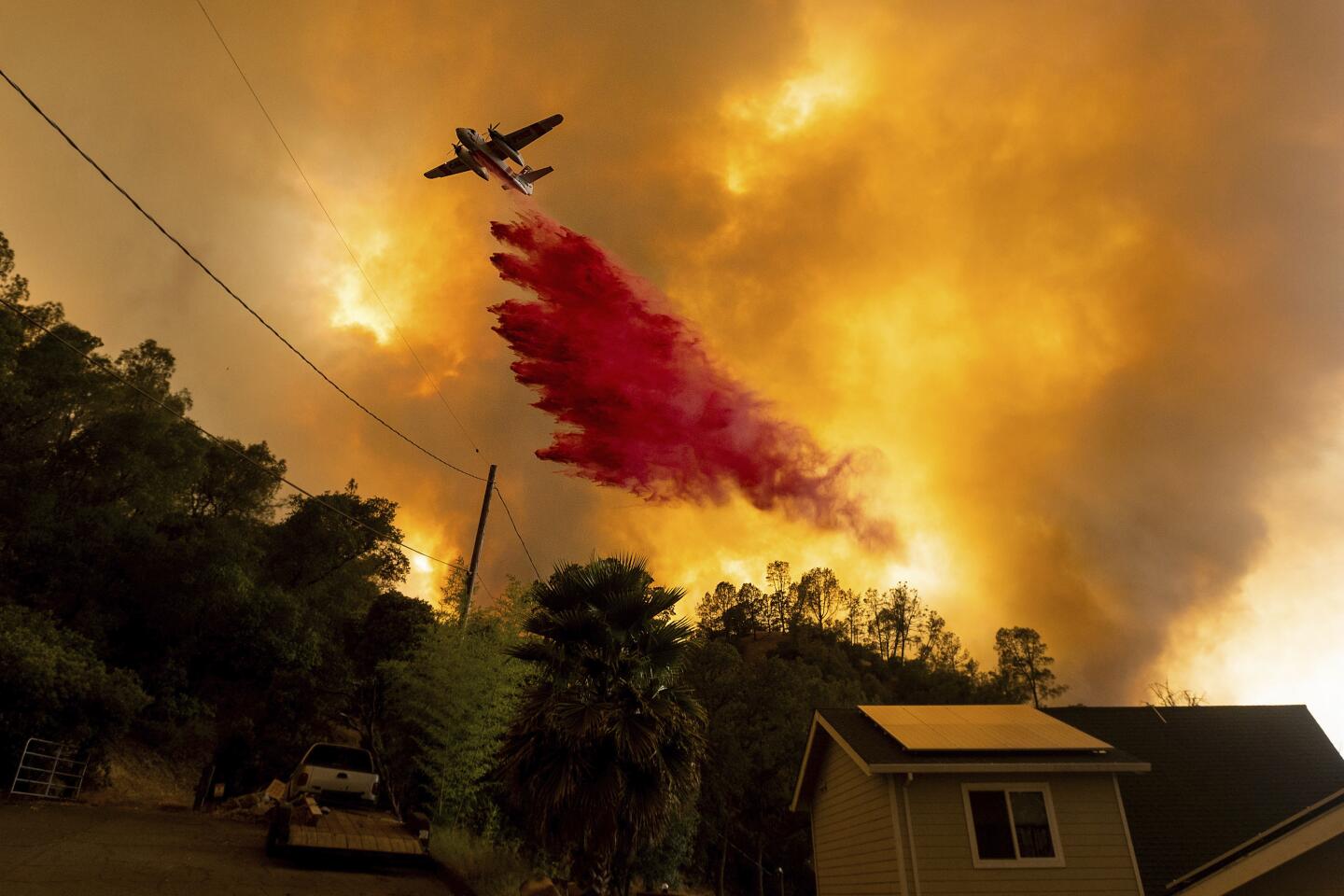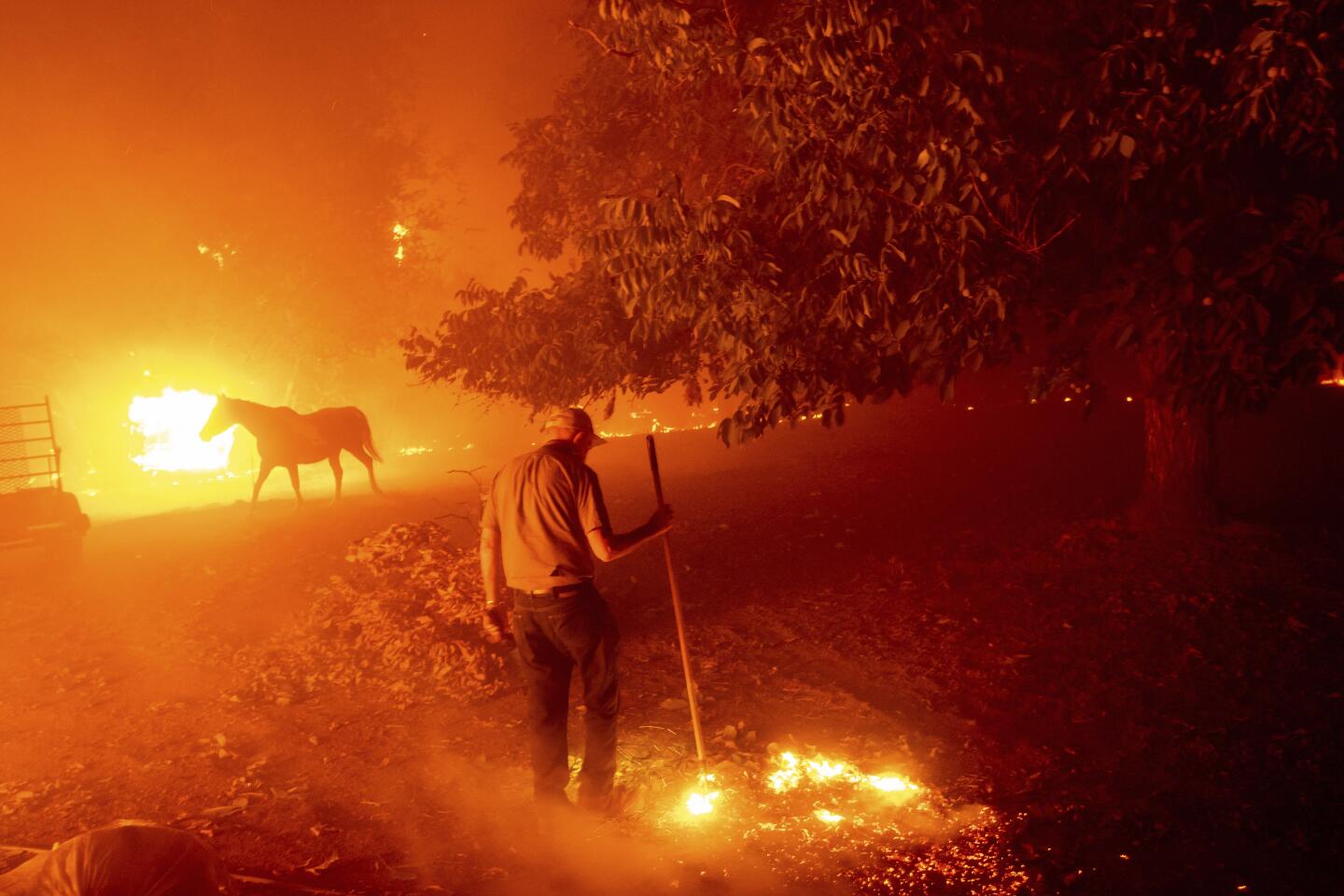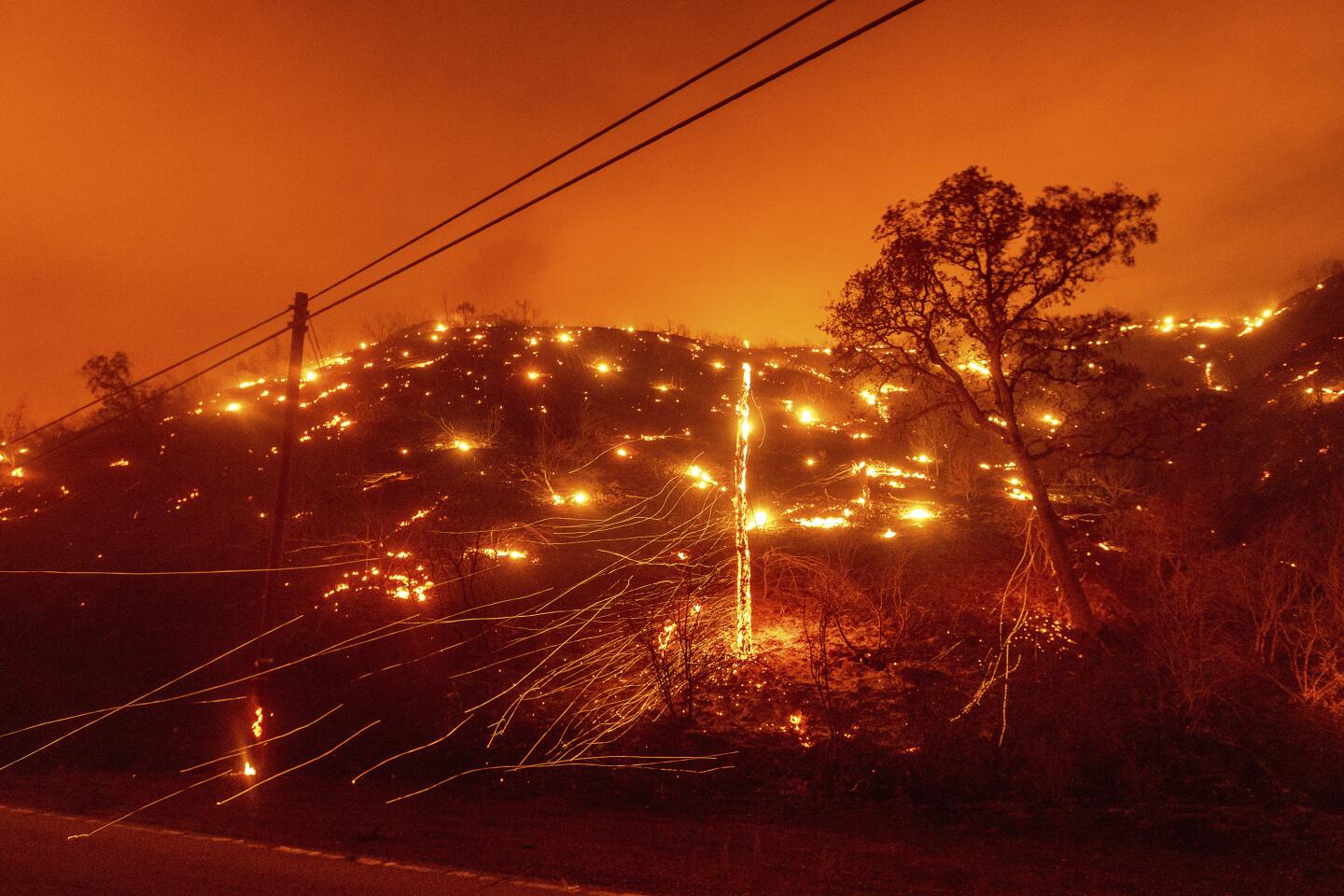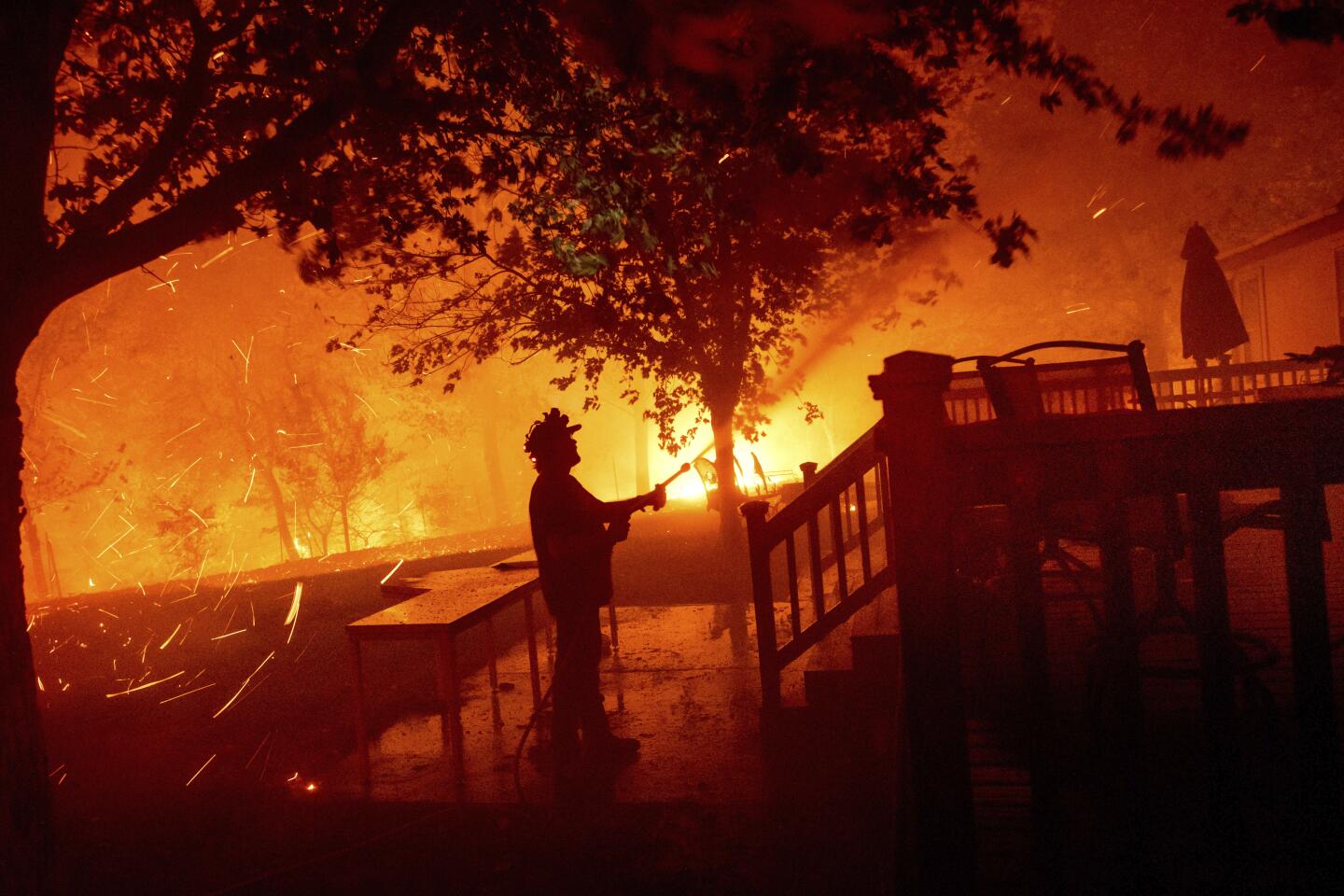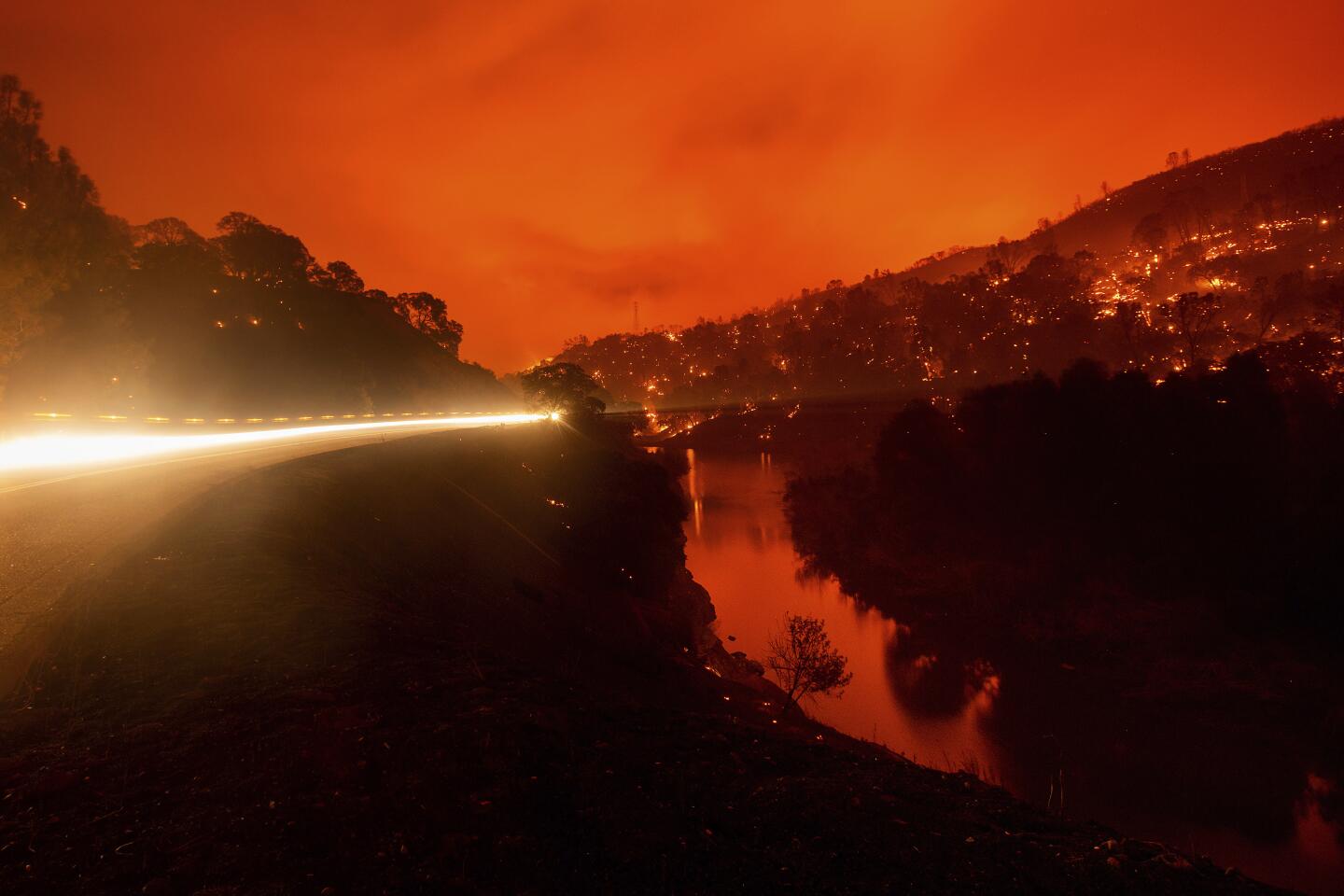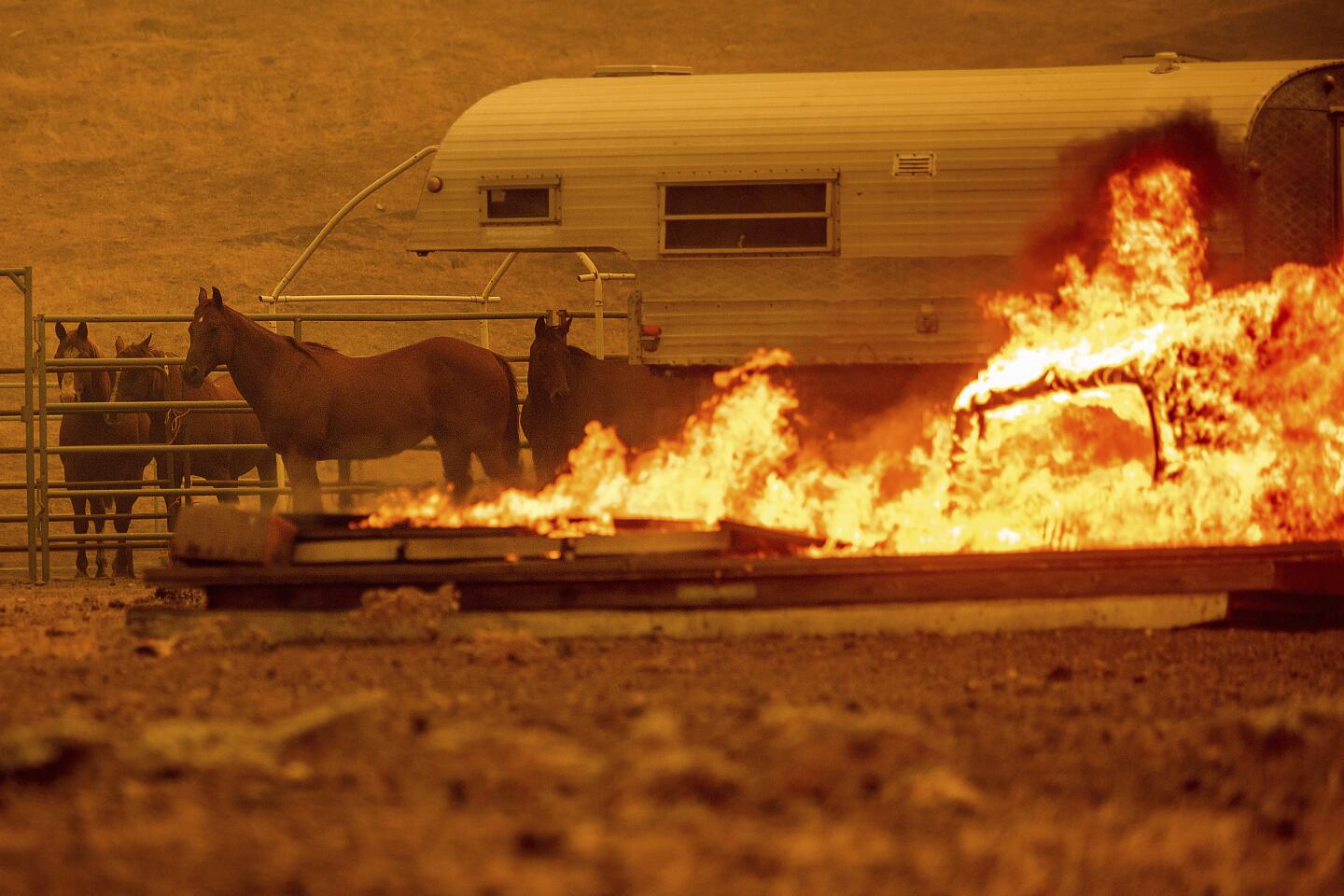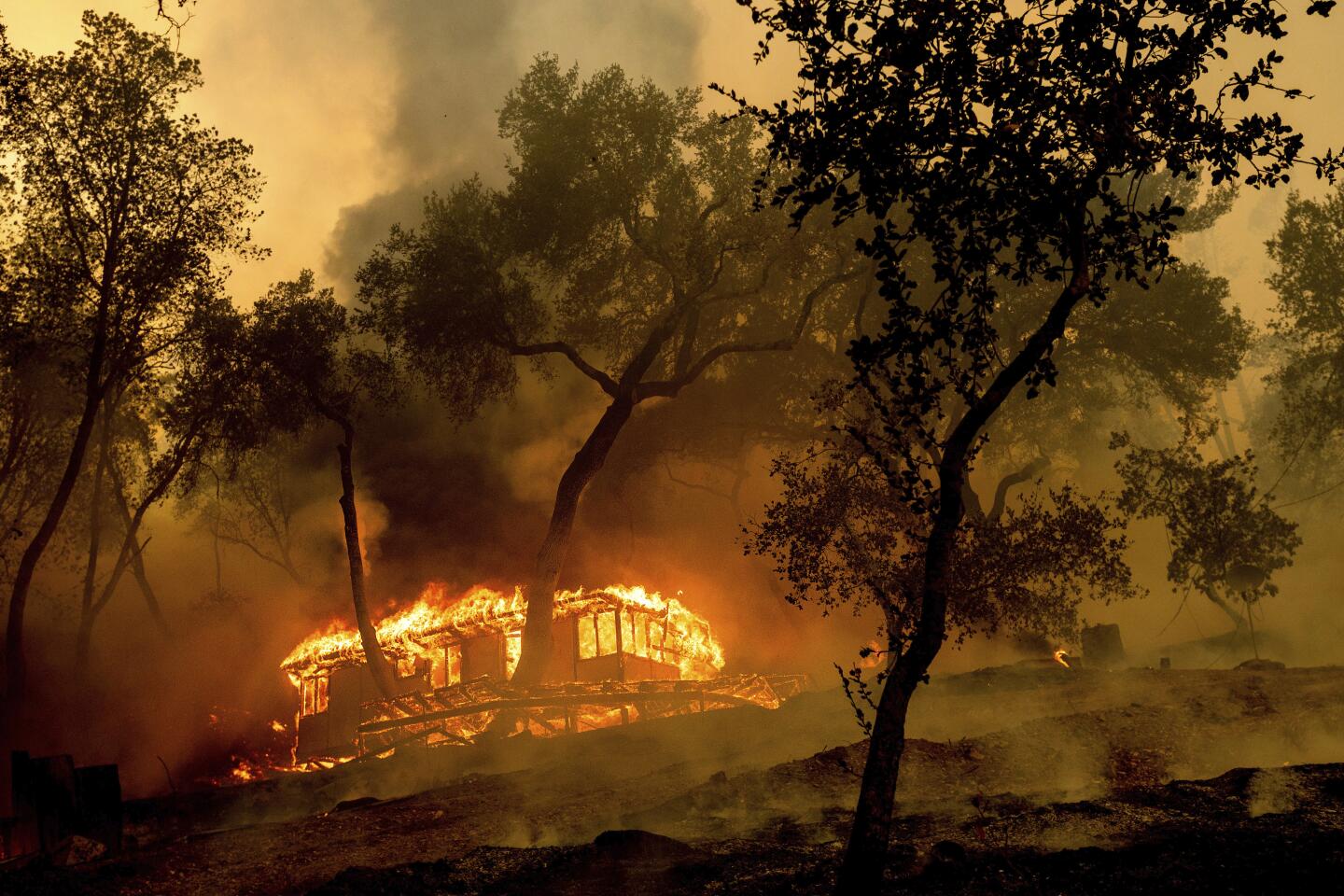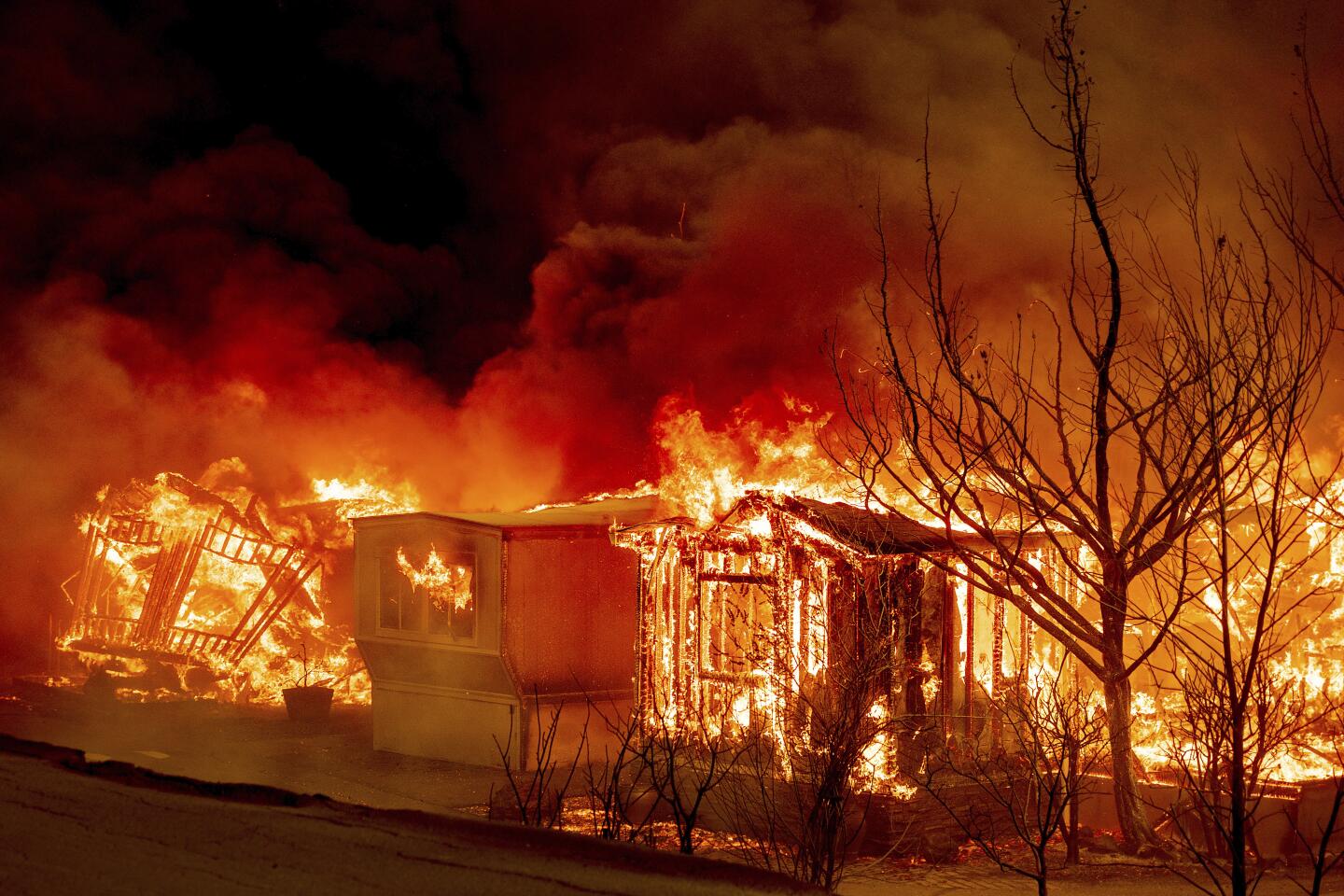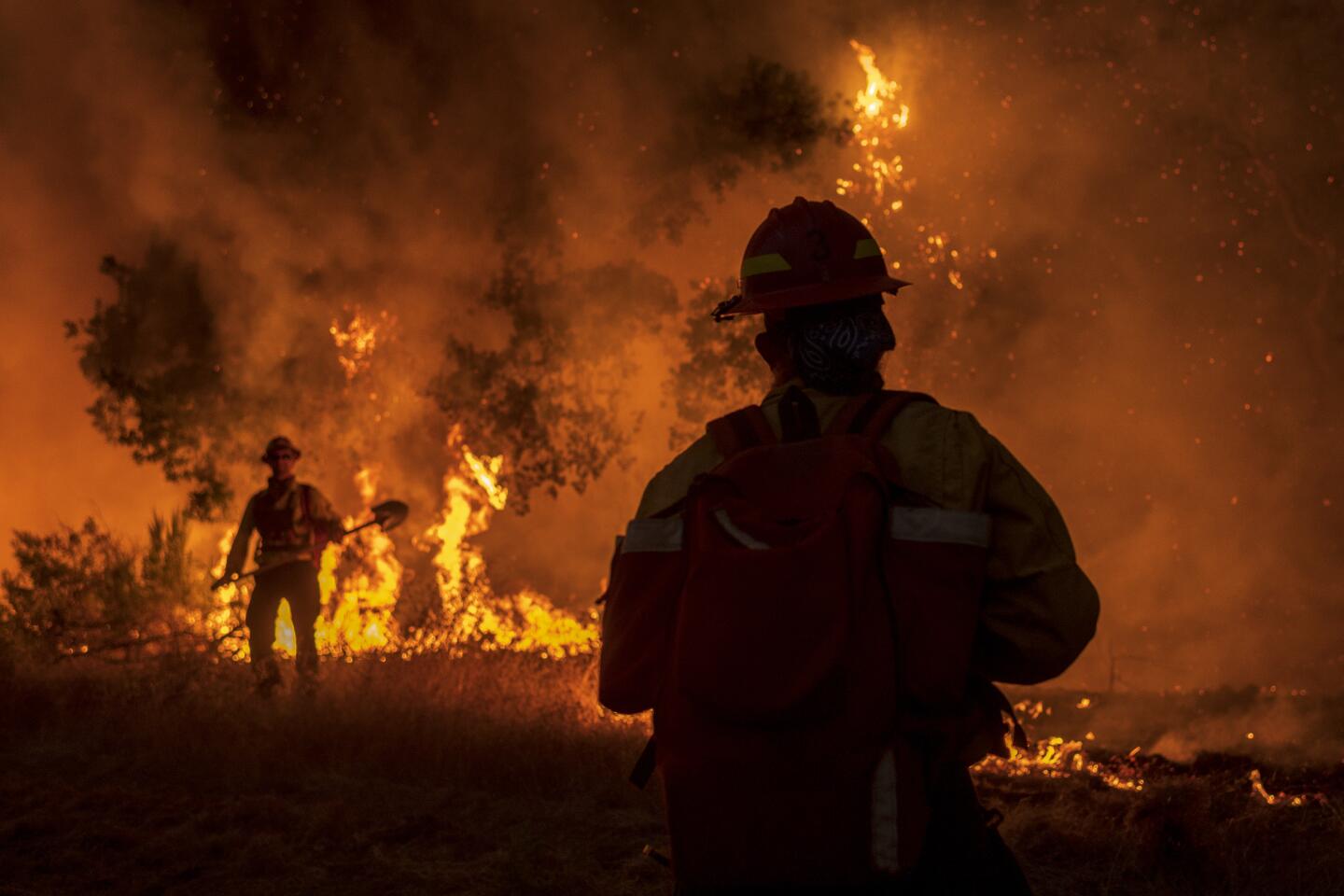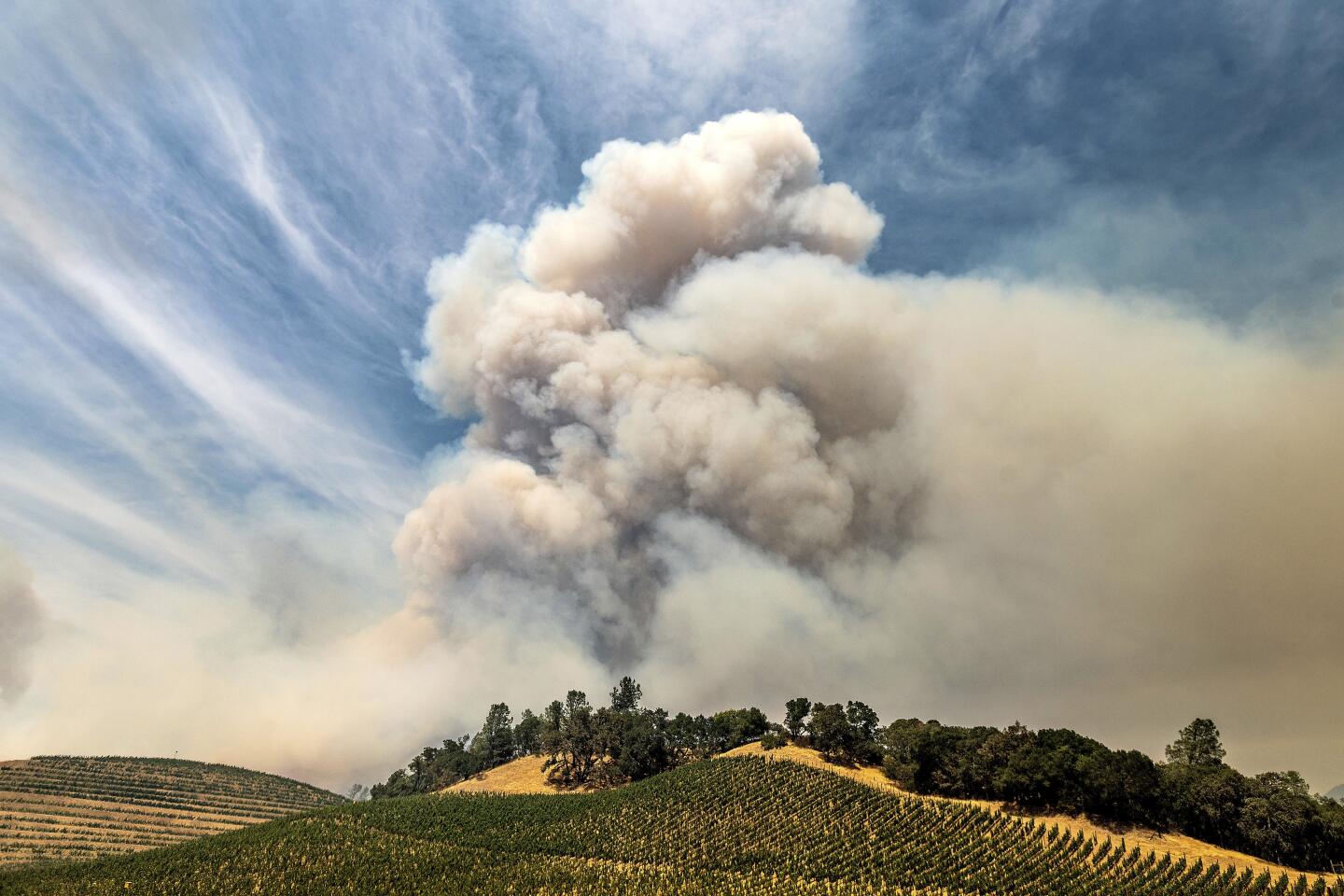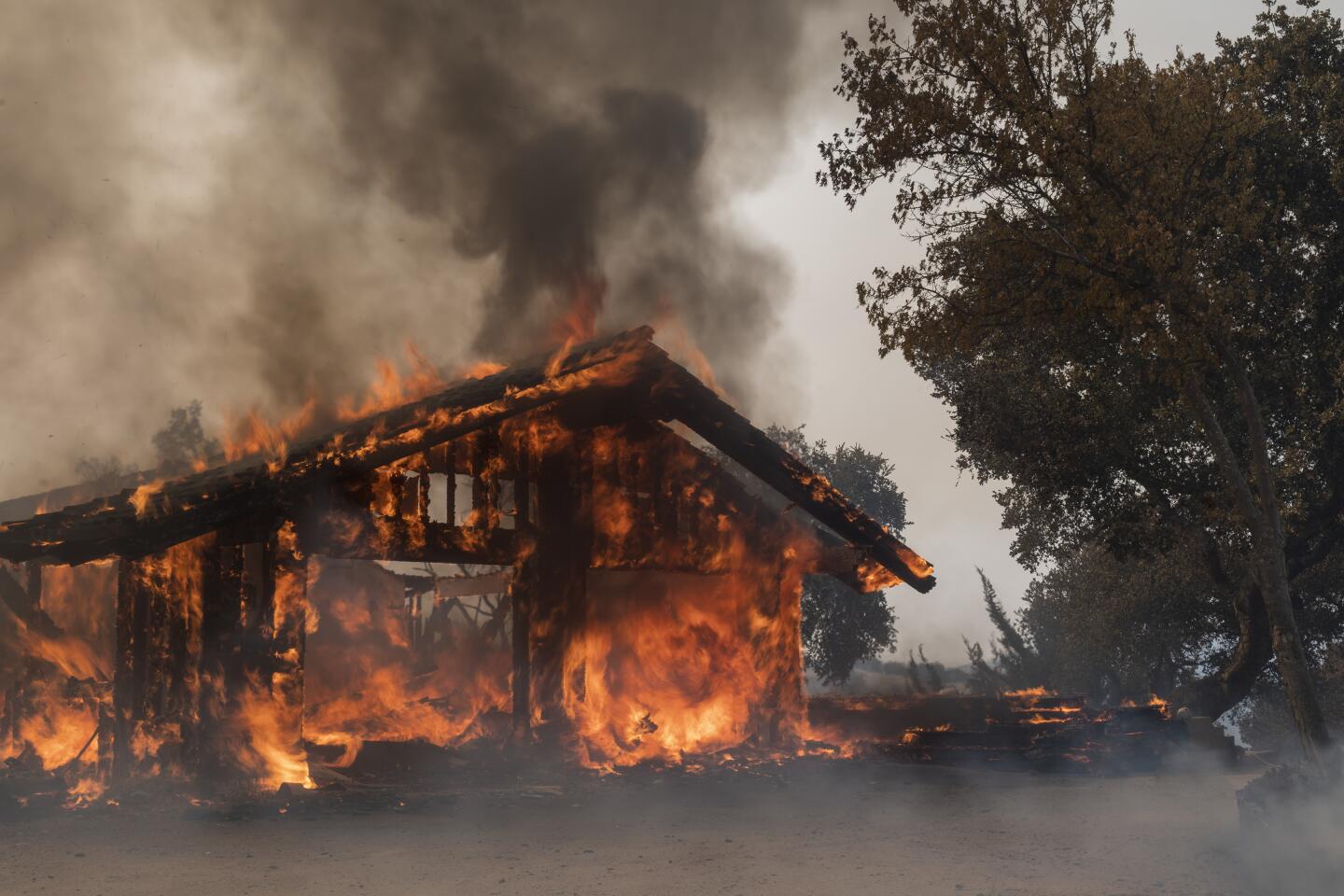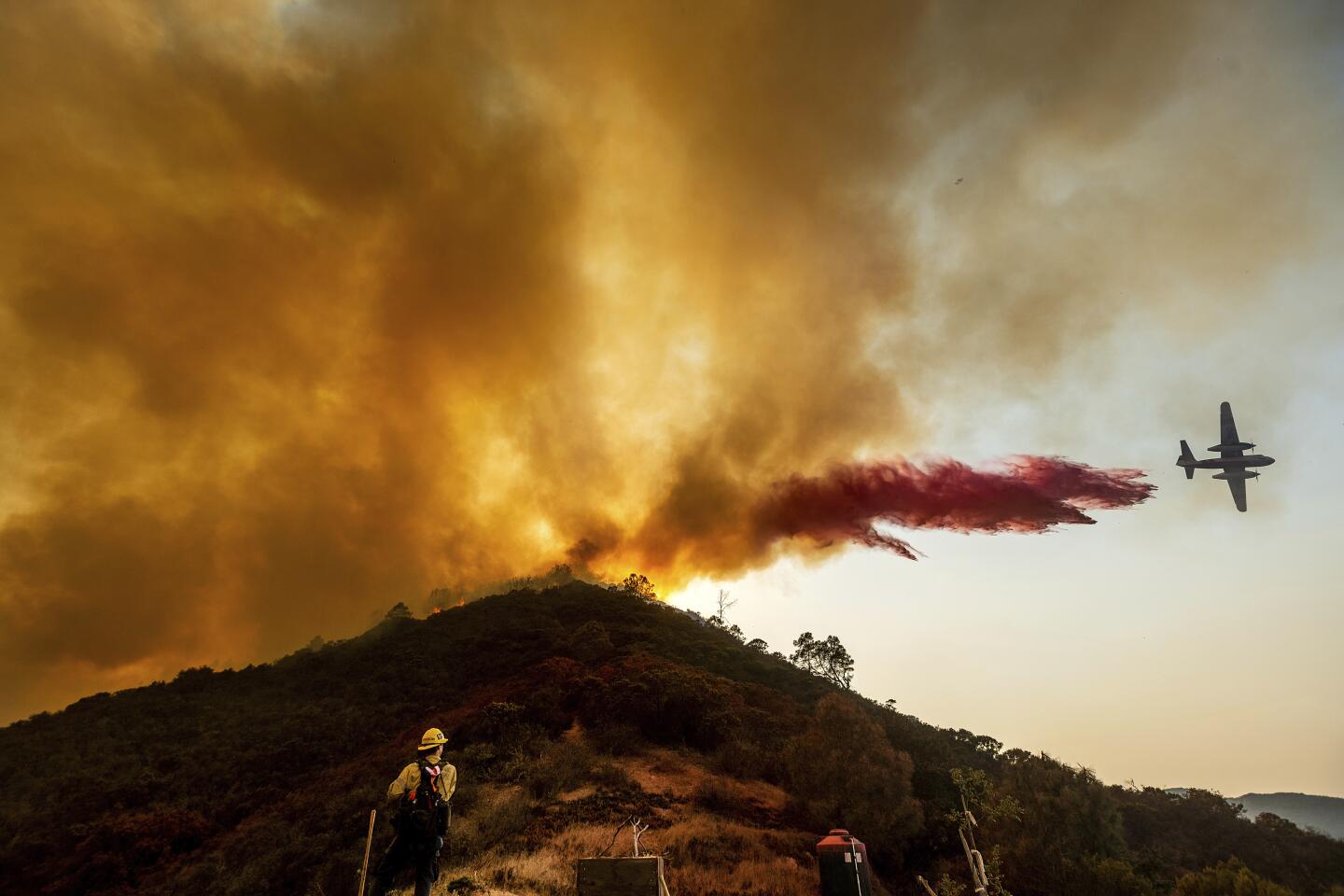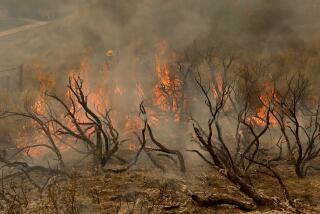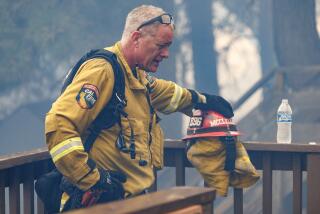Firefighters ârunning on fumes,â begging for equipment, manpower amid firestorms
BEN LOMOND, Calif. â Wildfires ravaged and menaced communities from Napaâs wine country to the coast above Santa Cruz on Friday, forcing California officials to make tough choices on which ones to fight as the state braced for a weekend that could include more lightning strikes.
In some places, officials said they were being turned down for state help and left to beg equipment and manpower from volunteers and local agencies.
For the record:
10:54 a.m. Aug. 23, 2020An earlier version of this story misidentified UC Berkeley professor Scott Lewis Stephens as Scott Lewis.
âMany of these firefighters have been on the lines for 72 hours, and everybody is running on fumes,â said Assemblyman Jim Wood (D-Healdsburg), whose district includes wine country areas currently under siege. âOur first responders are working to the ragged edge of everything they have.â
More than 930,000 acres have burned so far in Northern and Central California â an area larger than the land mass of Rhode Island â with little containment, in part because firefighting resources are stretched beyond capacity by the number of blazes.
On Thursday, 376 fires burned in the state, according to the California Department of Forestry and Fire Protection. But by Friday, there were about 560 active blazes, including two separate groups of fires, known as the LNU Lightning Complex and the SCU Lightning Complex, that have resulted from the convergence of about two dozen fires.
The two complexes are among âthe largest fires the state of California has had to battle in recent memory, arguably in modern recorded history,â said Gov. Gavin Newsom during an afternoon briefing.
A third massive blaze has also grown in rural areas in San Mateo and Santa Cruz counties.
Scott Lewis Stephens, a professor of fire science at UC Berkeley, said some of the new burns were probably from a massive lightning storm last weekend that saw more than 12,000 bolts hit California, many unusually close to cities including San Francisco. Those strikes may be causing âholdover firesâ that can ignite and appear days or weeks later after smoldering undetected, he said.
Tony Scardina, deputy regional forester for the U.S. Forest Service, said the stateâs 18 federal parks have also seen up to a 300% increase in campfires sparking wildfires this year, as more people seek the wilderness as a getaway from pandemic quarantines.
The National Weather Service in Sacramento issued a weather watch from Sunday through Tuesday mornings for dry lightning from the state capital to Lassen County near the Oregon border. Though the heat wave that helped explode so many recent fires has broken, the possibility of new storms were crushing to many firefighters, 12,000 of whom are battling both flames and fatigue.
With more need than can be met by the crews available, fire experts said state officials are now forced to prioritize which fires will get resources and change how those resources are being used. Though officials often deploy crews and equipment to surround fires with defensible lines so that they can be contained, fire experts said the focus is now is on saving lives and structures, and predict that the current blazes will burn for weeks.
âAt the statewide level, we do get into this mode where we start wondering where the biggest loss is going to be, whatâs the highest priority, and that is where the resources are going to go,â said Lenya Quinn-Davidson, a fire expert with the University of California Cooperative Extension.
Scardina, the U.S. Forest Service official, said priorities are being set by state and federal authorities continually evaluating the larger picture of where they will have the most impact to protect lives, property and infrastructure, but the calculations are difficult.
âAt this point we have to triage, we have to set priorities, we have to make some tough choices,â Scardina said. âEvery fire manager, every leader at a local level, every community, is really focused on their fire obviously and for valid reasons. ... The best we can do is ... be transparent and honest with people about the limitations that we have [and] be clear with them about how we set priorities.â
The lack of equipment and outside fire crews was evident Friday as a smoky evening fell in Ben Lomond, a heavily forested town in the Santa Cruz Mountains. The fire there has destroyed scores of homes and structures and is burning up steep hills that crest near the campus of UC Santa Cruz, normally an education hub of 18,000 students.
Ben Lomond Fire Chief Stacie Brownlee said she requested help from Cal Fire and was told it had nothing to offer. The rejection startled her. In the 10 years sheâs been chief and 36 years sheâs served, she said sheâs never seen the state unable to help.
She said she is running out of basic equipment, including hoses, radios and hand tools, and feels as though theyâve been abandoned.
âWeâre sleeping just two to five hours,â she said. âWeâre just trying to get a handle on this.â
Matt Sanders, a volunteer firefighter for Ben Lomond, said he and his colleagues have barely slept since Monday. Their force, which is 27 strong, is being supplemented by retirees, many fighting to save their own homes. Todd Ellis, a Menlo Park Fire District training captain who lives in town and is captain of the volunteer force, on Friday persuaded his chief to send a engine, which arrived in time to fight a blaze at a retreat center amid redwoods.
Billy See, one of the Cal Fire incident commanders, said personnel on this fire increased by almost 100 from the previous night, up to about 1,000, but itâs âstill not enough.â
Farther north, the LNU Lightning Complex â now the second-largest fire in state history, having consumed more than 302,000 acres â brought mixed news.
In the Solano County city of Vacaville, halfway between Sacramento and San Francisco, some residents were able to return home from evacuations Friday, and officials reported the blaze was 15% contained. But on the northern part of that fire, new evacuation orders were issued for the Sonoma County enclave of Guerneville, where the blaze was burning strongly in rugged territory.
Newsom said the state sent assistance to that fire overnight, nearly doubling the number of firefighters from about 587 yesterday to more than 1,000 Friday.
California in recent weeks has also hired 830 seasonal firefighters meant to replace prison crews that are not available due to early releases prompted by the pandemic.
Newsom also said Friday that 10 states had offered mutual aid to California so far, and he has sent out more requests, including to Canada and Australia.
So far, dozens of extra engines, manpower, airplanes and other resources have arrived from Oregon, Arizona and other states.
But there is also the threat of a long fire season, with the current blazes burning for weeks â a scenario experts said was possible with containment a lesser priority. Smoke is also hampering aerial firefighting.
There are so many conflagrations in California that aircraft have been hopscotching across the state trying to slow ones that pose the greatest threats, officials said.
Smoke from the LNU Lightning Complex fire has at times settled over the area and kept scouting aircraft from descending low enough to see where the blaze was most active. Such âair attackâ provides intelligence for crews on the ground and guides other aerial endeavors.
âYou just avoid the areas where thereâs no visibility,â said Scott Ross, public information officer on the LNU Complex fire.
âIf you didnât have air attack, you wouldnât have fixed-wing tankers, helicopters, theyâd all just be flying up there willy-nilly.â
Meanwhile, the SCU Lightning Complex fire, threatening rural areas around Silicon Valley, has only three water-dropping helicopters helping at a given time because the flames have stayed mostly in rugged terrain, said public information officer Dominic Polito.
Nationally, the fire threat is also at its highest level. Some 90 large fires have burned in 14 states, leaving many places taxed for resources, according to federal fire authorities.
âWe have more people, but itâs not enough,â said Newsom. âWe have more air support, but itâs still not enough.â
More to Read
Sign up for Essential California
The most important California stories and recommendations in your inbox every morning.
You may occasionally receive promotional content from the Los Angeles Times.
